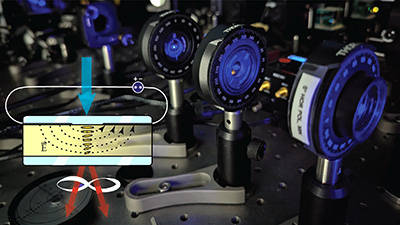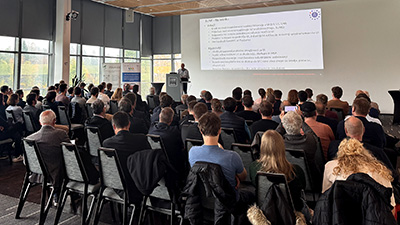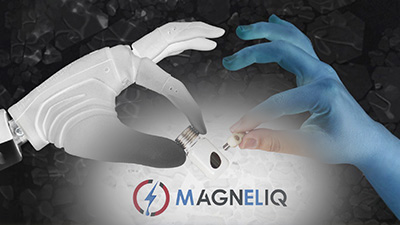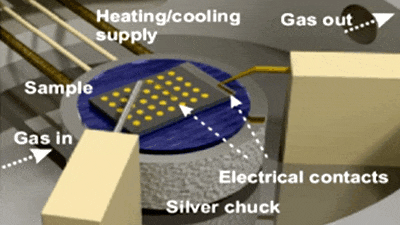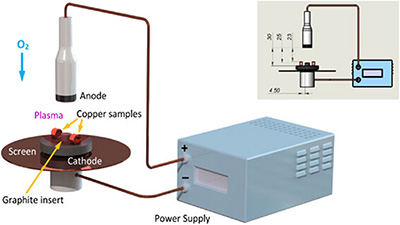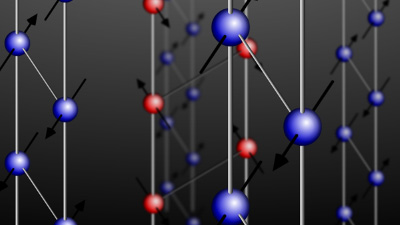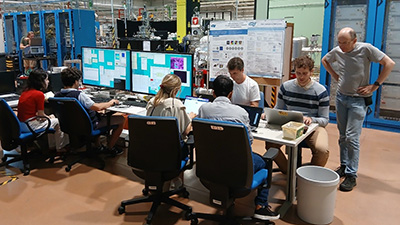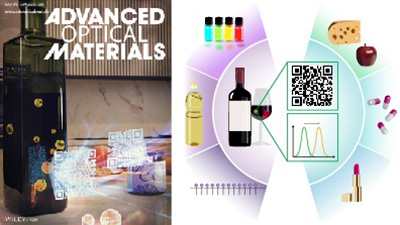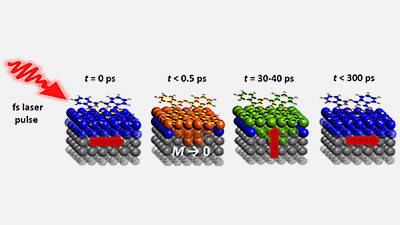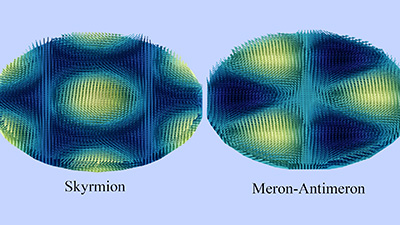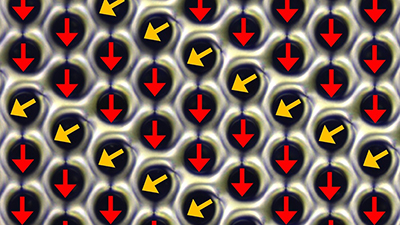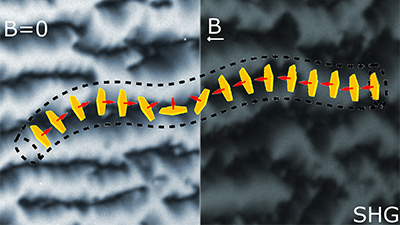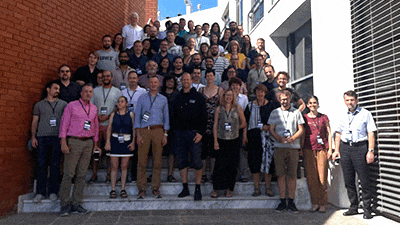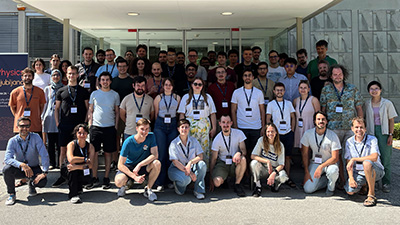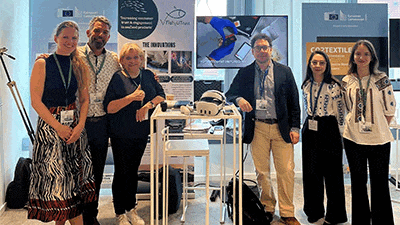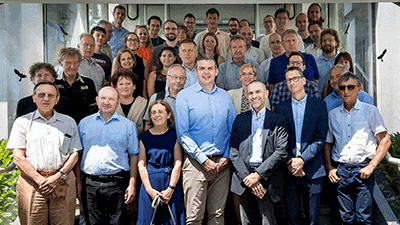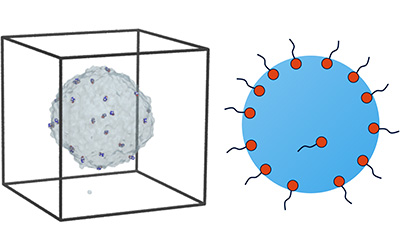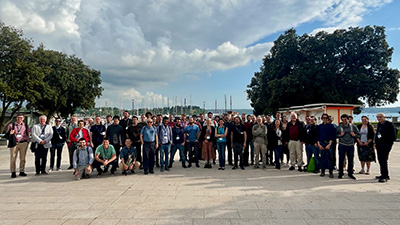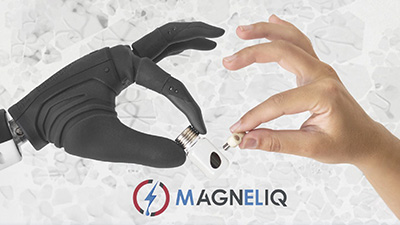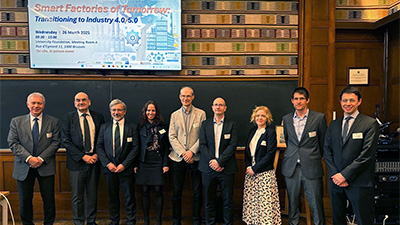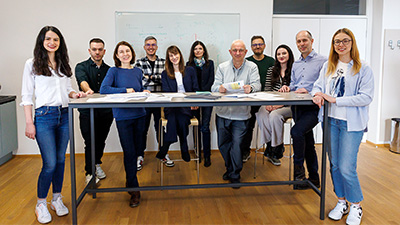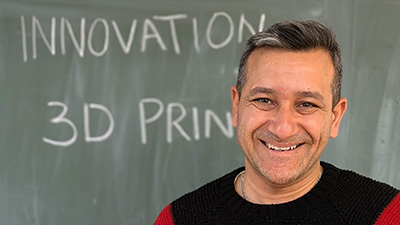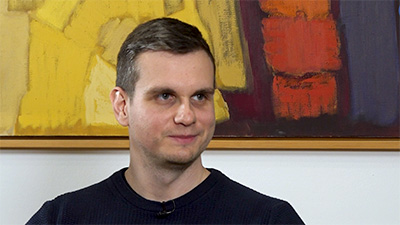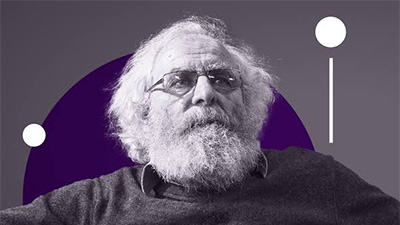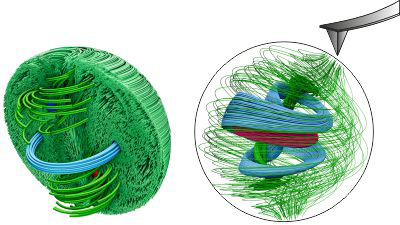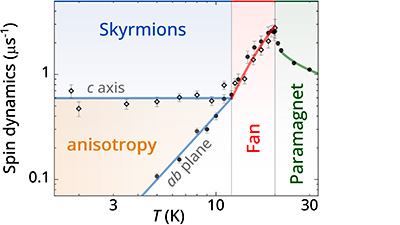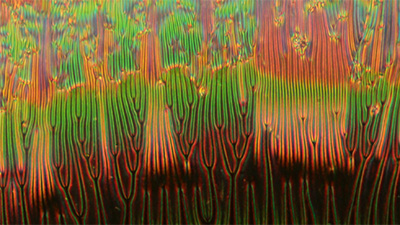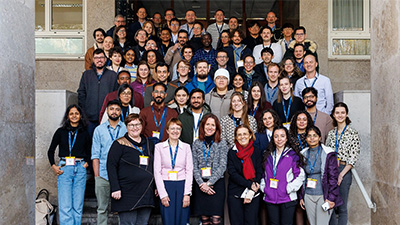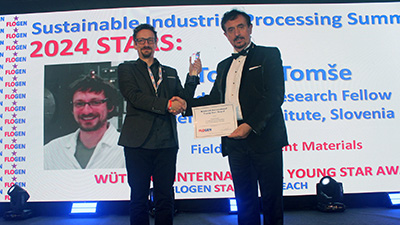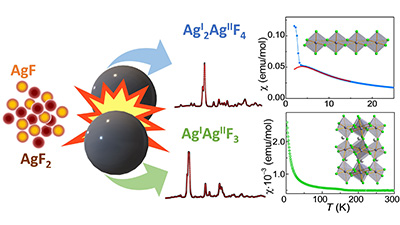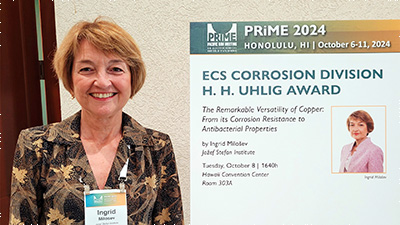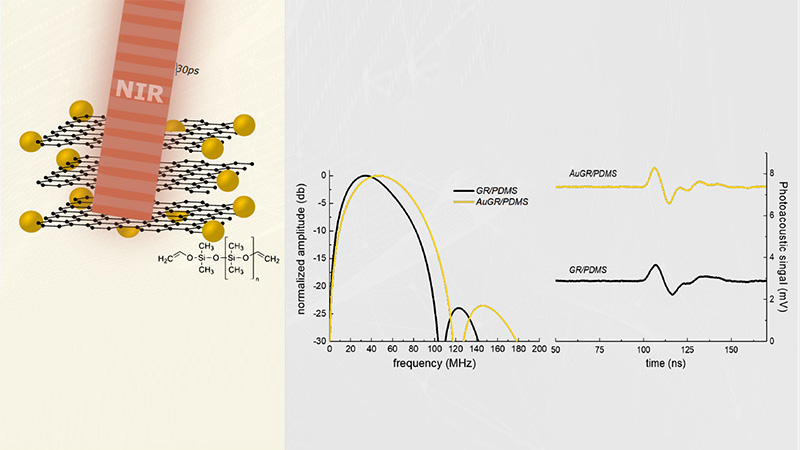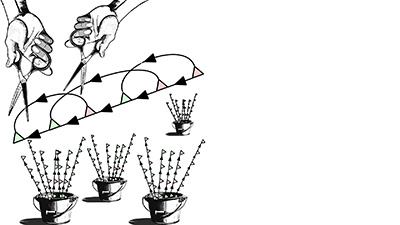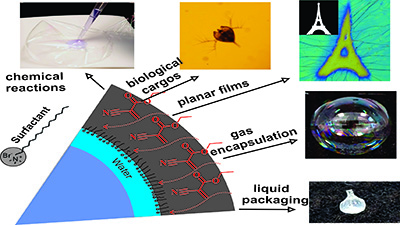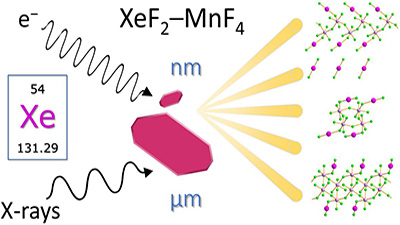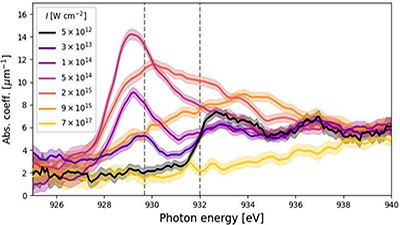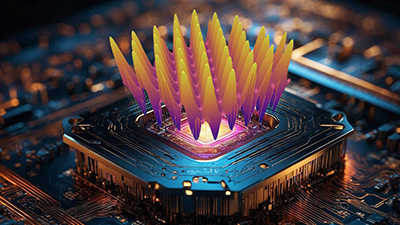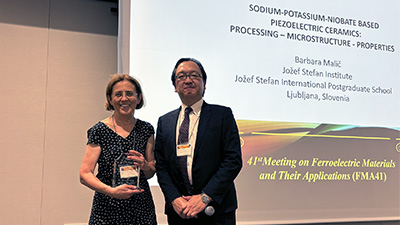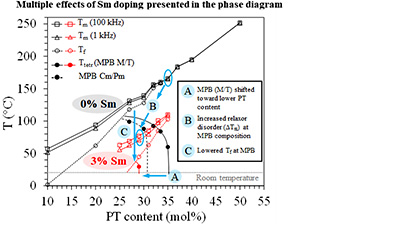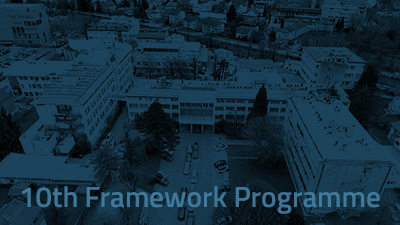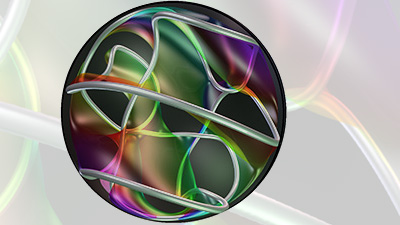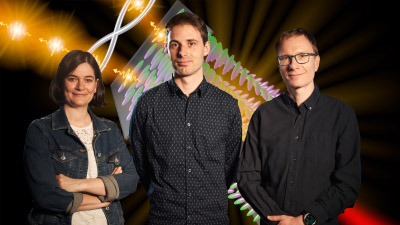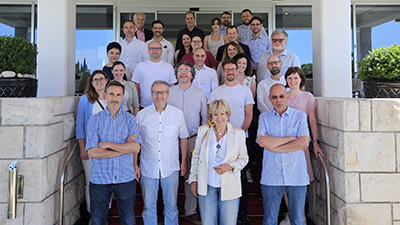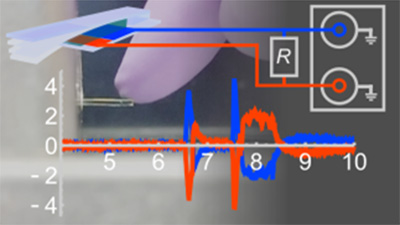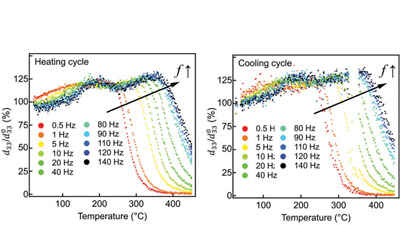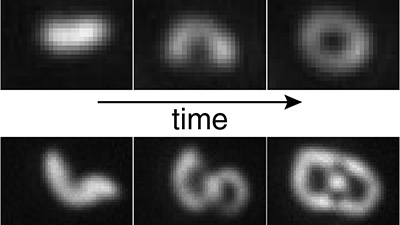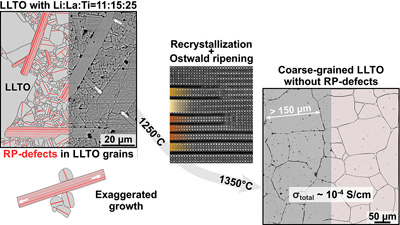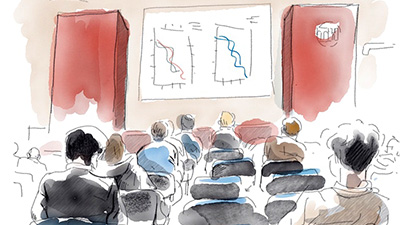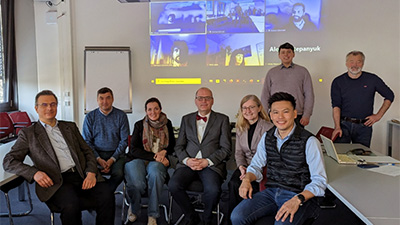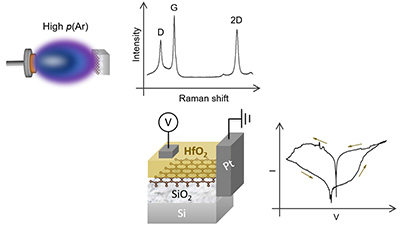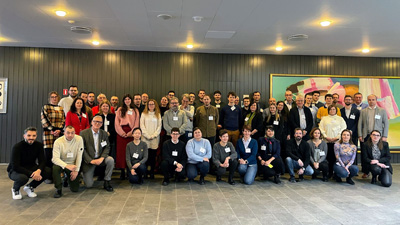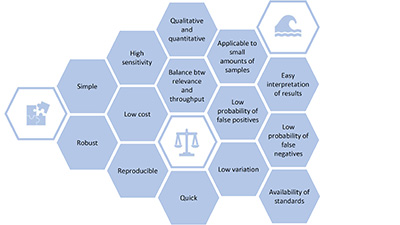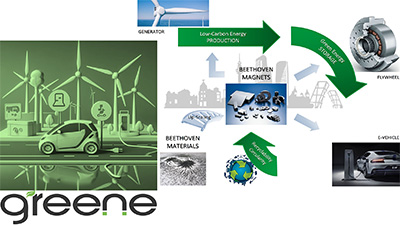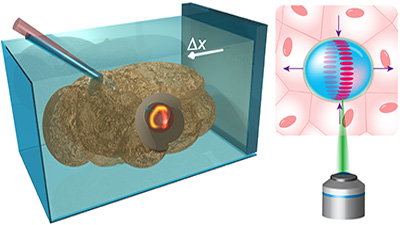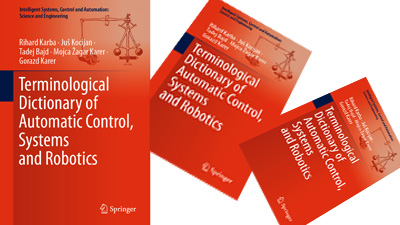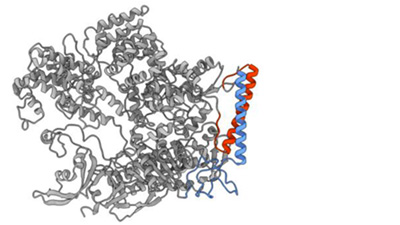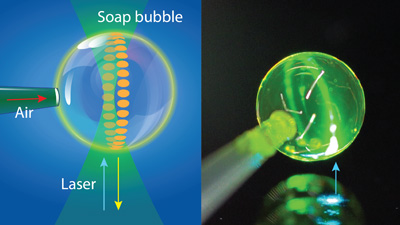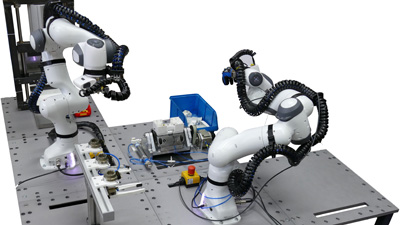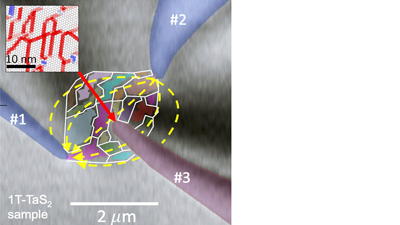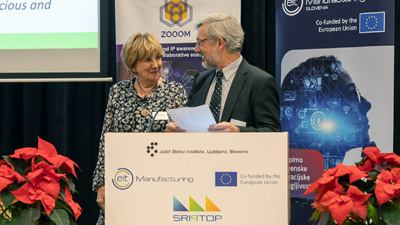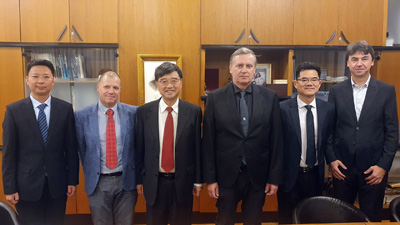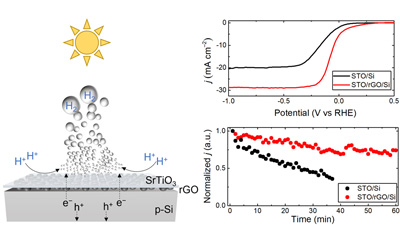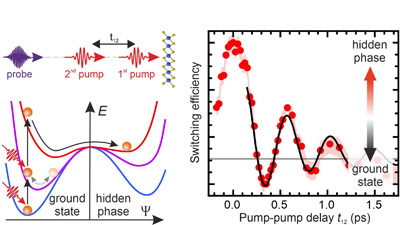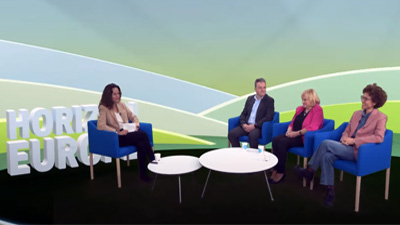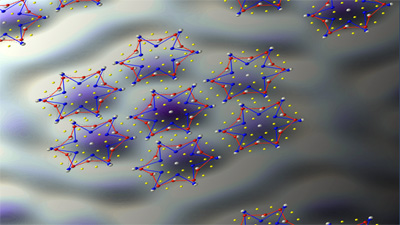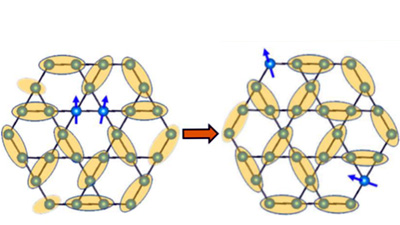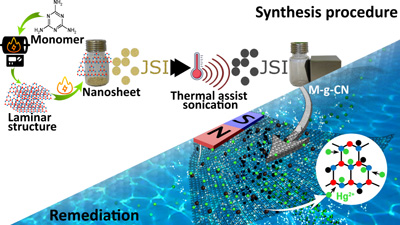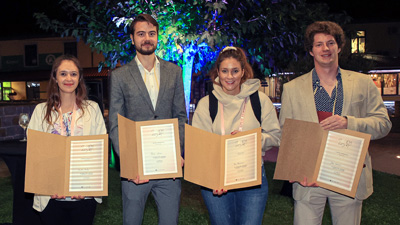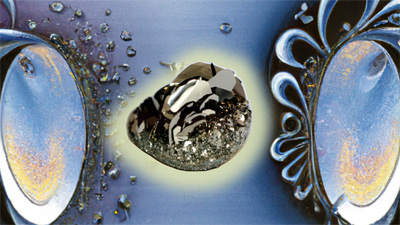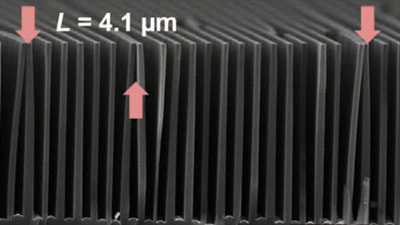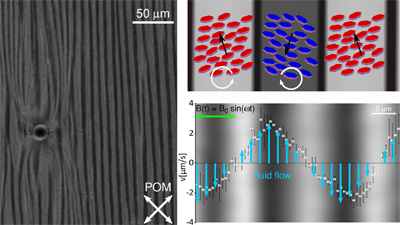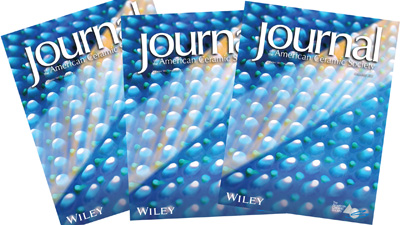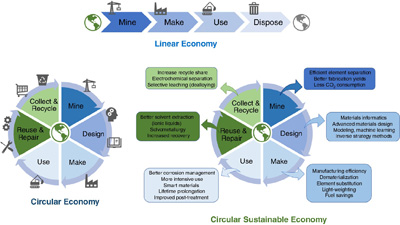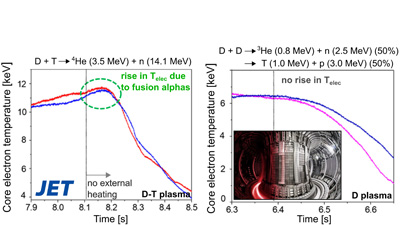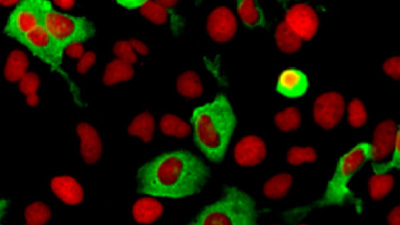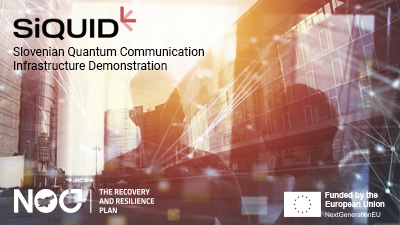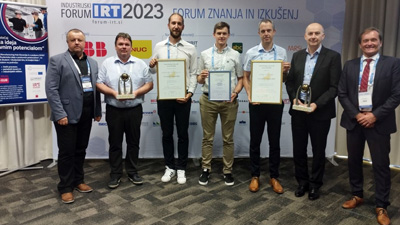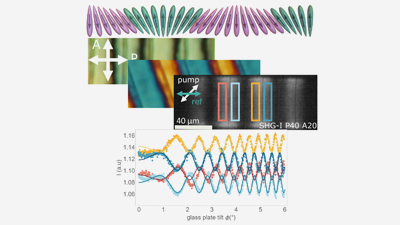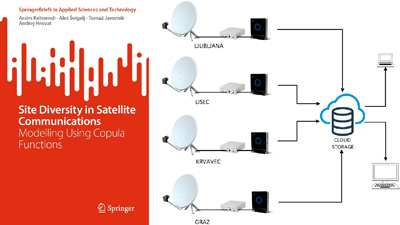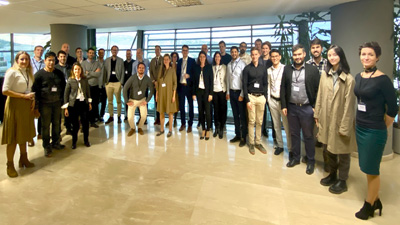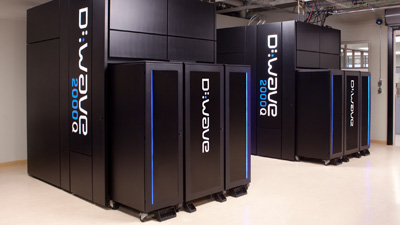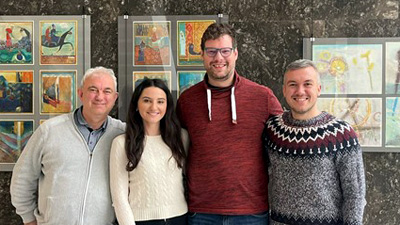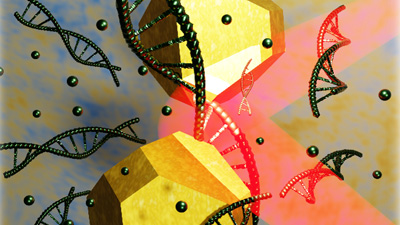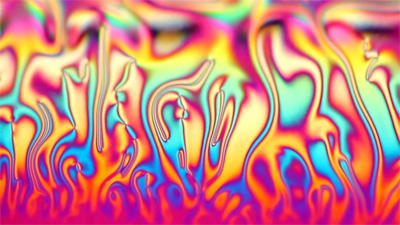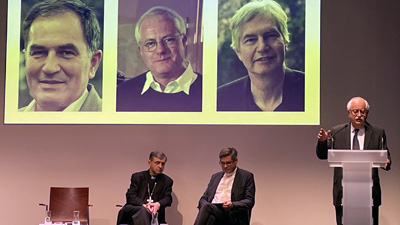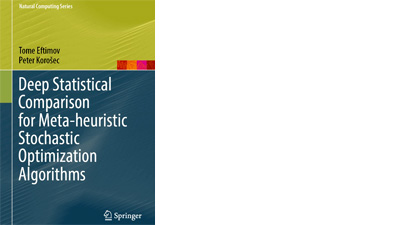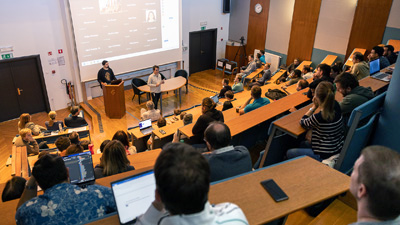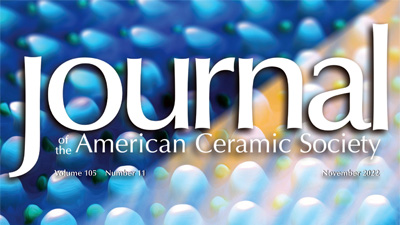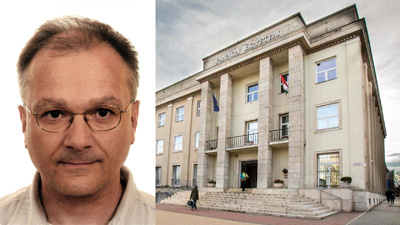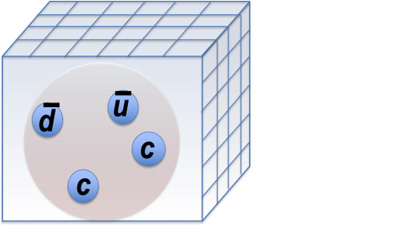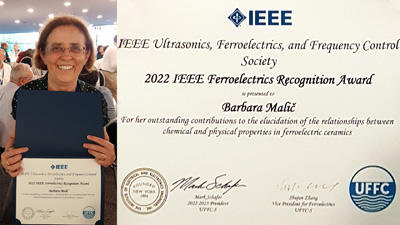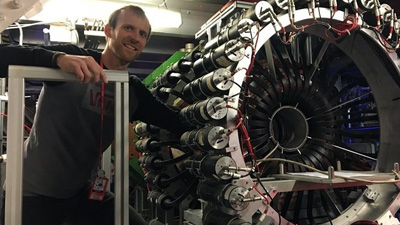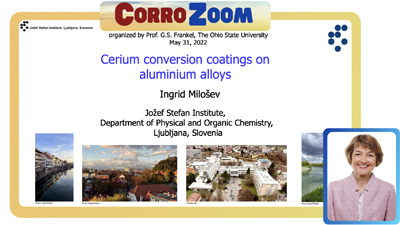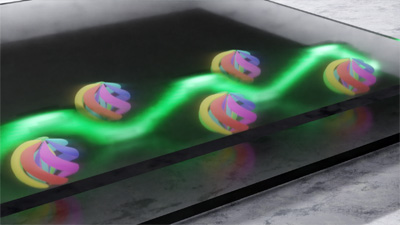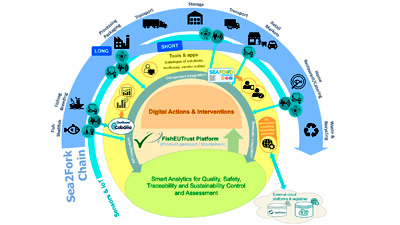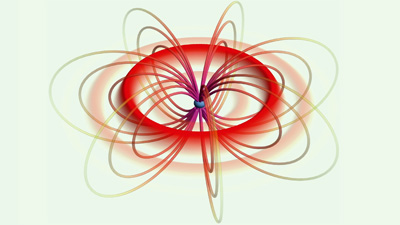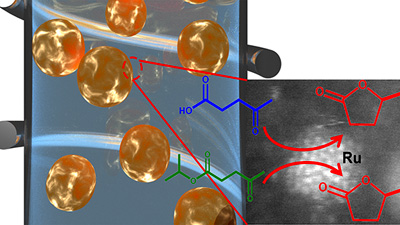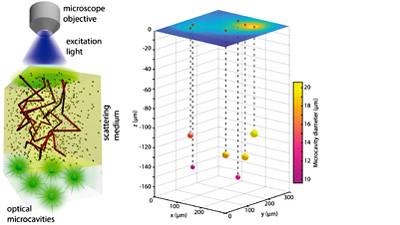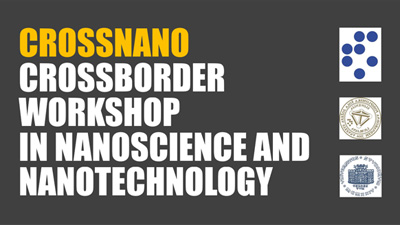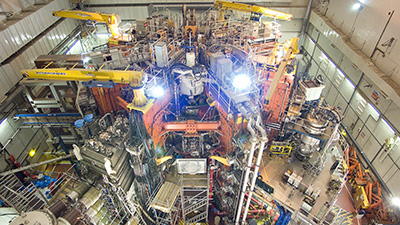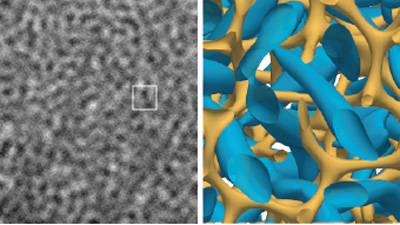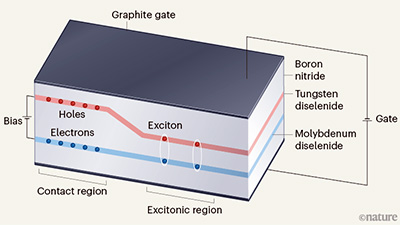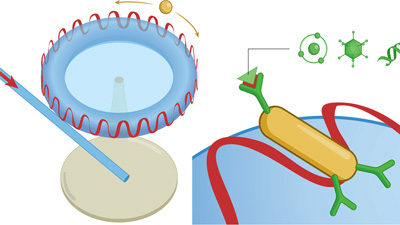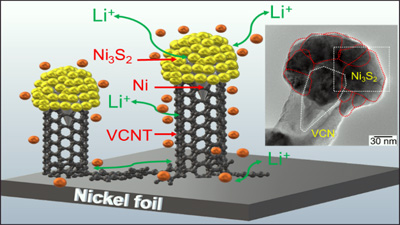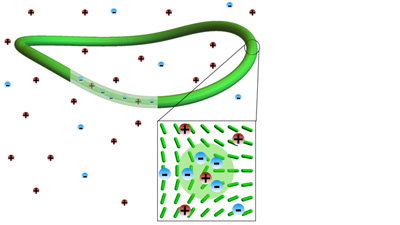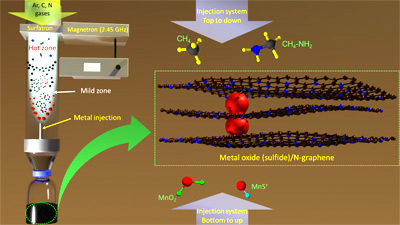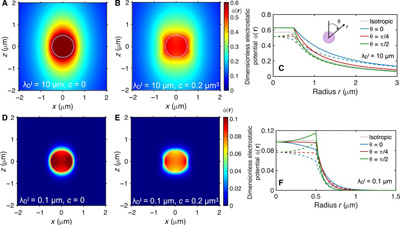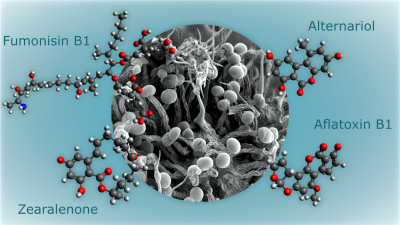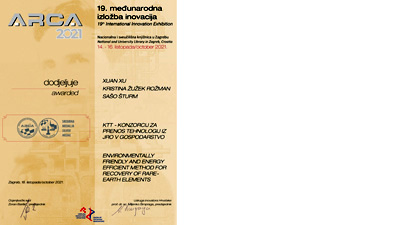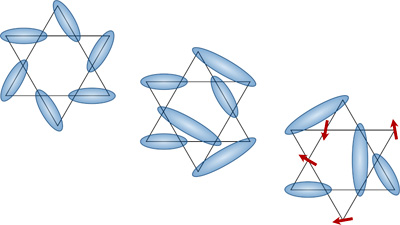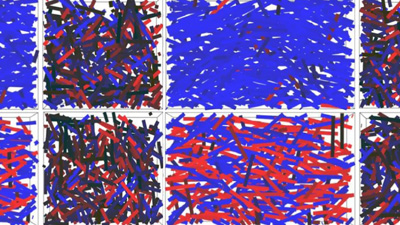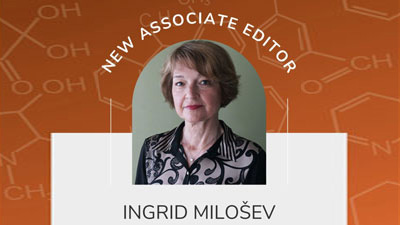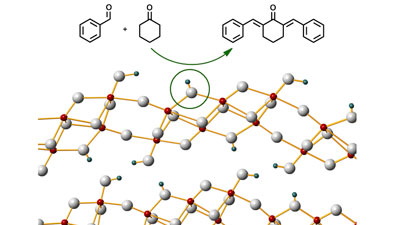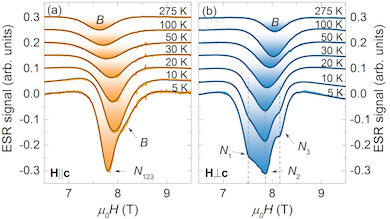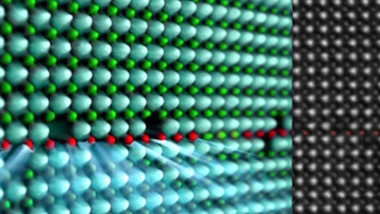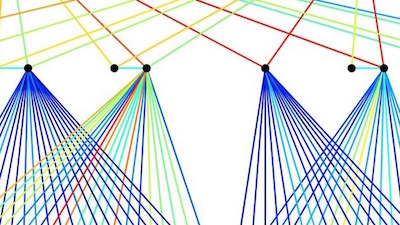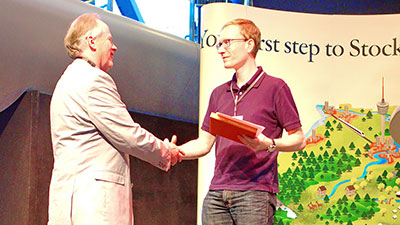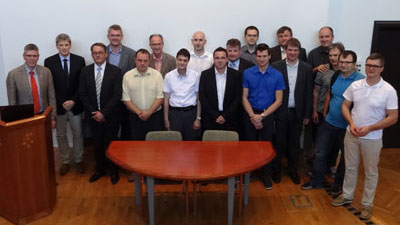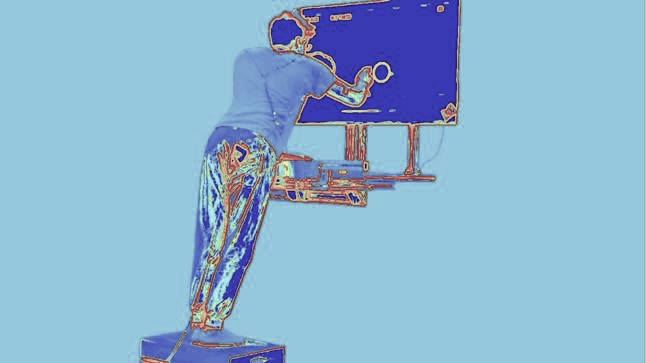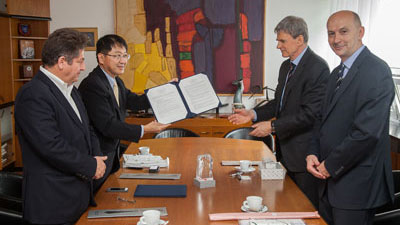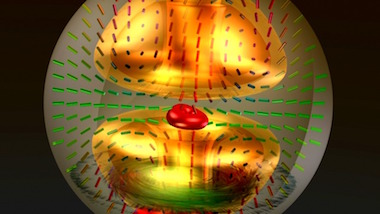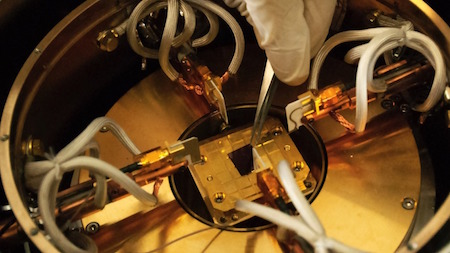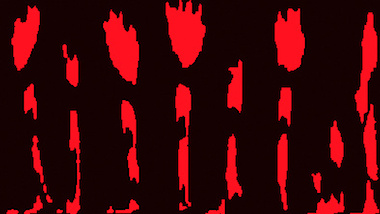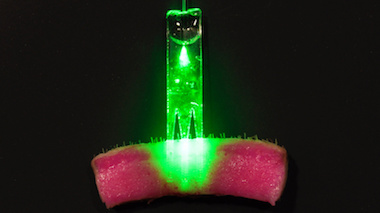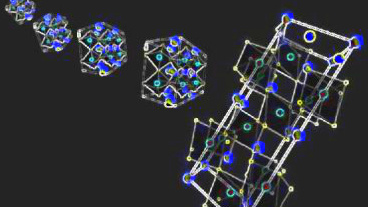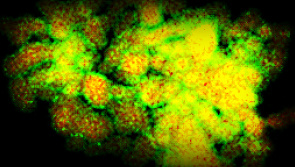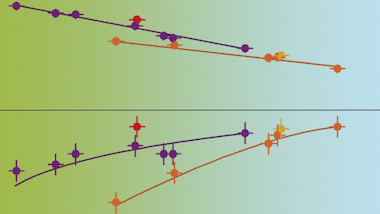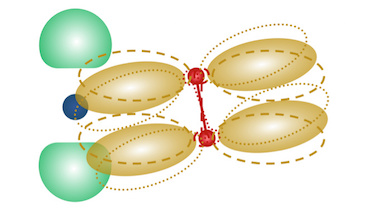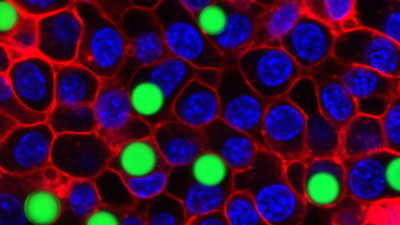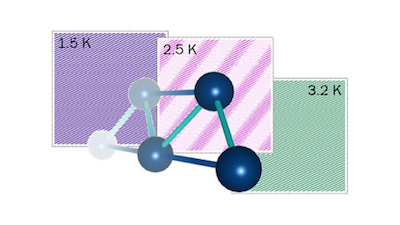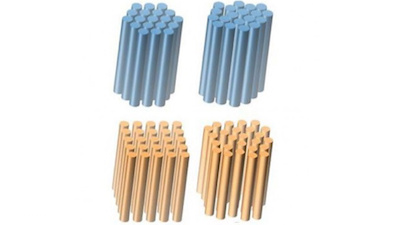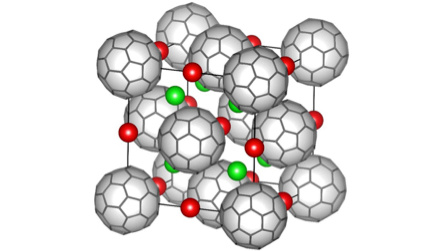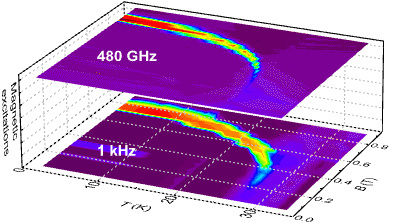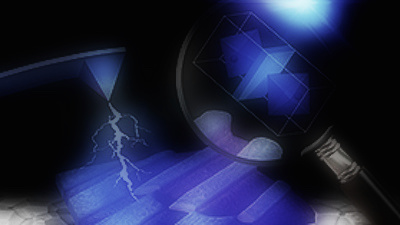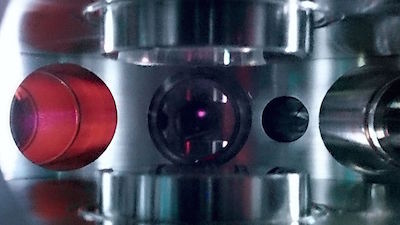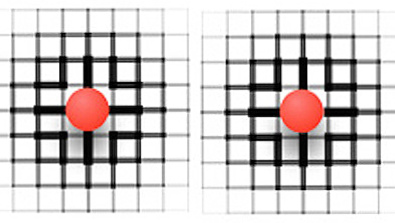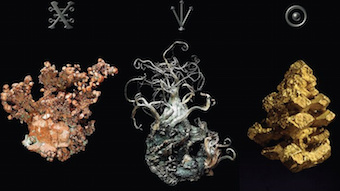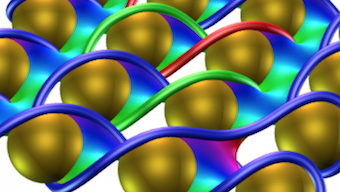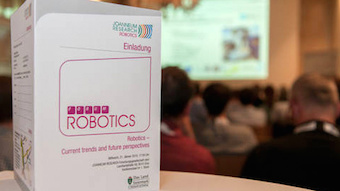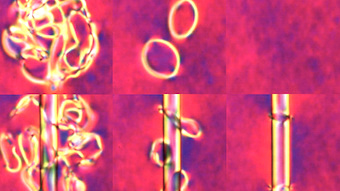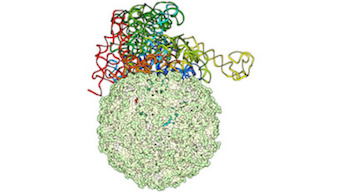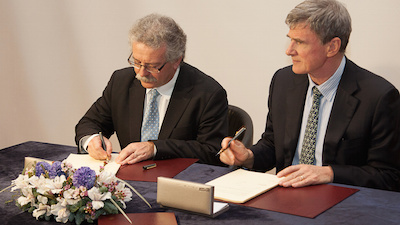NEWS ARCHIVE |
Sara Klopčič, Aljaž Kavčič in dr. Matjaž Humar from Lab for biophotonics, soft photonics and quantum optics and Condensed matter physics department at Jožef Stefan Institute and Faculty of Mathematics and Physics at the University of Ljubljana have together with Dr. Nerea Sebastian from Department of Complex Matter demonstrated, in a recently published article Electrically and Geometrically Tunable Photon Pair Entanglement from Ferroelectric Nematic Liquid Crystal in Advanced Science, that quantum-entangled photon pairs can be generated in ferroelectric nematic liquid crystals (FNLCs), while simultaneously allowing continuous control over the degree of quantum entanglement. This control can be achieved by adjusting the sample thickness and molecular twist, or in real-time by applying an external electric field. Such continuous and real-time tunability represents an important advantage of liquid crystals over classical solid nonlinear crystals and paves the way for the development of so-called quantum displays.
The well-attended event "Challenges and Opportunities of Slovenian Robotics," which took place on October 15, 2024, at the Four Points by Sheraton Ljubljana Mons hotel, once again confirmed that the Slovenian research and industrial community in the field of robotics is among the most recognized in Europe. The event, co-organized by the Jožef Stefan Institute and the Slovenian Robotics Association, brought together representatives of research institutions, industry, and users of robotic technologies from Slovenia and abroad. In their speeches, Prof. Dr. Matjaž Mihelj, President of the Slovenian Robotics Association, and Prof. Dr. Andrej Gams, coordinator of the European ROMANDIC project at the Jožef Stefan Institute, emphasized the importance of cooperation between research and industry stakeholders as one of the key driving forces, and the role of SRIP Factory of the Future in strengthening the innovation, research, and business capabilities of the Slovenian economy.
Within the MAGNELIQ project (EU Horizon 2020, No 899285), researchers from the Materials Synthesis and Complex Matter Departments, with partners (Faculty of Electrical Engineering and Informatics of the University of Maribor, Prensilia, s.r.l.), developed three sensors that were recognized as important innovations by the European Innovation Council (EIC). An optical sensor for measuring electric and magnetic fields (No. 5150, All-optical external-field sensor) and rotation (No. 5152, Contactless magneto-optic rotation sensor) are based on a magneto-optical fluid embedded in an optical fiber and is suitable for use in process automation and robotics, even under extreme conditions (radiation, submarine, toxic, or explosive environments). The third sensor (No. 51047, Distributed Liquid Force Sensor) is based on a magneto-electric fluid, which enables force measurement over a large area, representing a significant improvement for robotics.
Accurate detection of volatile organic compounds at trace concentrations holds a great promise for future health, safety, and environmental applications. In a recent Nature Communications report, Aleksander Matavž from the Condensed Matter Physics Department, together with colleagues from KU Leuven, address this challenge by introducing kinetic selectivity achievable in nanoporous crystals into the domain of chemical sensing. Their sensors measure the diffusion characteristics of adsorbed gases, which can differ by orders of magnitude even for very similar compounds. As a result, a single kinetic sensor can distinguish and quantify gases at ppm concentrations, even in mixtures with high humidity—outperforming a state-of-the-art commercial electronic nose. In addition to its applicative and market potential, the developed method represents a powerful tool for studying diffusion in thin films over a wide concentration and temperature range.
The colleagues from Department of Gaseous Electronics at Jožef Stefan Institute developed a fast-processing micro-plasma method for producing a plasmonic metasurface densely packed with electromagnetic hotspots, based on vertically aligned Cu₂O/CuO nanosheets decorated with silver nanoparticles. This lithography-free scaffold enables surface-enhanced Raman scattering with detection limits in the low nanomolar range for fast-tracing of different explosives such as tetryl and HMX, outperforming many commercial sensors while ensuring reproducibility. The approach also uncovers laser-dependent shifts in vibrational modes that define the nanostructure, providing valuable input for machine-learning-based data processing. Because the plasma treatment requires only short processing and is scalable simultaneously, the technique paves the way for compact lab-on-chip devices. Such devices could identify trace explosives and hazardous chemicals on-site, offering robust, portable, data-driven tools for border security, forensic applications, and environmental monitoring. The research was published in the journal Small.
The journal Nature Reviews Physics has published a review article entitled “Platforms for the realization and characterization of Tomonaga–Luttinger liquids”. In the article, Assist. Prof. Dr. Martin Klanjšek from the Condensed Matter Physics Department at the Jožef Stefan Institute, together with an international group of collaborators, provides an overview of the field of physics that has developed over the past two decades based on the theoretical concept of the Tomonaga–Luttinger liquid. The concept describes the physics of interacting quantum particles in one dimension, where, compared to the more common case of three dimensions, the role of interactions is so strong that it leads to very unusual collective behavior, which is, however, entirely universal, applying equally to fermions, bosons, and anyons. The article demonstrates how this concept has proven successful in describing experimental results in such diverse systems as organic conductors, carbon nanotubes, quantum wires, topological edge states in quantum spin Hall insulators, Josephson junctions, Bose liquids in nanocapillaries, and quantum spin chains and ladders.
Researchers of the Department of Low and Medium Energy Physics at Jožef Stefan Institute: Janez Turnšek, Klemen Bučar, Andrej Mihelič, Špela Krušič and Matjaž Žitnik, report new experimental results in Physical Review Letters. Upon passage of intense resonant XUV light of the free-electron laser FERMI through millimeters thick helium gas at a few tens of millibars pressure, self-amplification of weak spontaneous decay from doubly excited state has been observed at the EIS-TIMEX beamline. Due to stimulated emission, the fraction of excited atoms emitting an XUV photon instead of an electron has significantly increased significantly. The effect of decay redirection together with the collimation of emitted light leads to 8 orders of magnitude larger number of XUV photons emitted in the forward direction. This result provides opportunity to test new theoretical models and encourages further research to improve the efficiency of XUV spectroscopy and contribute to the development of new coherent light sources at short wavelengths.
Researchers Abdur Rehman Anwar, Maruša Mur, Matjaž Humar from Condensed Physics Department of the Jožef Stefan Institute and coworkers from Aristotle University of Thessaloniki, Greece, have developed microlasers made entirely out of edible materials. The microlasers that can be embedded directly inside edible products, were designed as barcodes, or as sensors/indicators for various food-related parameters. Illuminating a food product, containing such microlaser(s), with a laser pulse, and measuring the emission spectrum enables remote measuring of pH, sugar concentration, etc. or reading encoded information e.g., on expiry dates and the food origin. The microlasers are entirely safe for consumption and do not alter the appearance or taste of food. The research on edible microlasers that could significantly enhance traceability, security and freshness monitoring of food, was published in Advanced Optical Materials, and had a significant media impact, with many media outlets publishing the story about edible lasers, including Science, Phys.org, Gizmodo and others.
Researchers from the University of Leeds and the Jožef Stefan Institute have presented new metal-organic structures for magnetic data storage with minimal energy input. In a study published in the prestigious journal Advanced Materials, they demonstrated a reorientation transition of the magnetic moment under the influence of molecular contacts with ferromagnetic films, resulting from competition between the perpendicular magnetic anisotropy induced by a heavy non-magnetic metal and the in-plane magnetic anisotropy caused by molecules. By changing the thickness of the ferromagnet or selecting the molecular overlay layer (C60 and various phthalocyanines), the transition temperature can be adjusted to around room temperature. Near the transition temperature, the direction of magnetization can be easily switched with a small energy input, either by electric current or optically, with a femtosecond laser pulse. The results indicate applications in heat-assisted magnetic recording technologies. Research into ultra-fast switching with short optical pulses was conducted by young researcher Jaka Strohsack and Assoc. Prof. Tomaž Mertelj from the Complex Materials Department at the Jožef Stefan Institute.
Asst. Prof. Matjaž Gomilšek from the Condensed Matter Physics Department at the Jožef Stefan Institute and the Faculty of Mathematics and Physics, University of Ljubljana has recently published a paper in Physical Review Letters, together with co-authors from the UK, Switzerland, Norway, Germany, Canada, and Japan. In the paper, they revealed a previously overlooked, “hidden” role of local chiral anisotropy in centrosymmetric topological magnets. Specifically, they found that local chiral anisotropy helps stabilize skyrmions and meron–antimeron pairs (different kinds of topological spin textures) in Gd2PdSi3, despite the material’s inversion symmetry, which precludes any global chirality. In their study, they combined atomistic simulations of magnetic ordering with measurements of polarized resonant X-ray scattering on Gd2PdSi3 at electron accelerators Diamond in the UK and PETRA III, DESY in Germany. The discovery represents an important step towards understanding centrosymmetric topological magnets, and greatly expands the possibilities for stabilizing topological spin textures in highly symmetrical materials.
Researchers from the University of Ljubljana and the Jožef Stefan Institute, Simon Čopar and Uroš Tkalec, in collaboration with researchers from American universities, reported on the spin ordering of topological defects in a confined nematic liquid crystal that forms under a thin layer of water. Shear forces at the boundary between the liquid crystal and water cause the elastic dipoles to align in the direction of the surface movements and thus store information about external stimuli. This results in ordered domain structures in the nematic, similar to those found in systems with polar order, such as ferromagnets, active matter and metamaterials. This is the first application of a conventional liquid crystal in which the director field is controlled by mechanical motion at an open interface and the defect configurations are read using polarization microscopy. The research, which promises new possibilities for the detection of dynamics in microfluidic environments, was published in Nature Physics. Finally, the article is accompanied by a commentary in the News & Views section.
In a recent paper in Advanced Materials, Peter Medle Rupnik, Nerea Sebastian and Alenka Mertelj from the Department of Complex Matter and Darja Lisjak from the Material Synthesis Department, in collaboration with researchers from Otto-von-Guericke University, Technical University Braunschweig and Merck Electronics KGaA, have demonstrated an example of a liquid that uniquely exhibits both ferroelectric and ferromagnetic ordering. The breakthrough focuses on a nanostructured liquid crystalline hybrid, composed of ferrimagnetic barium hexaferrite nanoparticles suspended in a ferroelectric nematic host, where director-mediated interactions drive the self-assembly of nanoplatelets in an intricate network. This system shows magnetically driven electric and nonlinear optical responses, alongside electrically driven magnetic responses. This achievement marks significant progress toward the development of multiresponsive multiferroic liquids, with promising potential for advanced applications in energy harvesting, nonlinear optics, and next-generation sensors.
On July 8-9, 2025, the members of the Natural Language Processing team of the JSI Department of Knowledge Technologies (E8) attended the kick-off meeting of a new European project, ELLIOT, in Thessaloniki (Greece). The project is devoted to training, fine-tuning and applying the next generation of Multimodal Foundation Models, with a commitment to robust, open and fair AI. With a total budget of 25 MIO EUR, this project will run for four years and is executed by a consortium of 30 partners from 12 countries, bringing together leading European AI researchers. With a budget of 700.000 EUR, the JSI team will contribute to foundation model fine-tuning and algorithmic fairness, and will lead the ELLIOT’s community building efforts by supporting the mobility of researchers and organising conferences, workshops, summer schools and other events, in collaboration with the ELIAS and ELLIS scientific consortia. With ELLIOT, Europe positions itself at the frontier of open, trustworthy, and socially beneficial artificial intelligence — capable of driving innovation in critical areas such as media, Earth observation, autonomous systems, and public services.
The Machine Learning for Physics (ML4Physics) Summer School successfully concluded last week in Ljubljana, Slovenia, bringing together 55 participants — 47 from abroad — for a week-long deep dive into the intersection of machine learning and physics. The school was organized by the COMETA COST Action, SMARTHEP, the SMASH MSCA COFUND, the Jožef Stefan Institute, and the Faculty of Mathematics and Physics at the University of Ljubljana. Its goal was to equip participants from diverse backgrounds with solid knowledge of cutting-edge machine learning topics relevant to physics. Each day combined morning lectures, afternoon hands-on exercises, and evening keynote talks or social and outreach activities. The school featured 11 lecturers and tutors, as well as two keynote talks by Uroš Seljak (UC Berkeley) and Nenad Tomasev (DeepMind), who shared insights from both academia and industry. The ML4Physics Summer School proved to be a vibrant platform for learning, collaboration, and exchange, demonstrating the power of interdisciplinary training in shaping the future of AI in science.
On 23–24 June 2025, the FishEUTrust project coordinated by prof. dr. Nives Ogrinc (Department of Environmental Sciences) participated in the "R&I for a Competitive Green Transition" conference in Brussels, a key satellite event of the European Research and Innovation Days. This high-level gathering brought together leading policymakers, researchers, and innovators to explore how science can power Europe’s green and blue transitions. Out of more than 150 projects, FishEUTrust was honoured to be one of just 15 selected to exhibit at the event. The project also caught the attention of European Commissioner Ekaterina Zaharieva, who learned about our cutting-edge tools to foster transparency and trust in sustainable seafood. The team showcased two of FishEUTrust’s flagship innovations: Sensor technology for detecting bacteria and antibiotics in seafood, An immersive Virtual Supermarket experience. Events like this highlight the important role of innovation in creating a sustainable future—and show how FishEUTrust is leading the way in building a more transparent seafood system for everyone.
A ceremonial event marking the 20th anniversary of the Slovenian Fusion Association (SFA) was held on 24 June at the ICJT, Jožef Stefan Institute. Founded in 2005, SFA is one of Europe’s leading groups in fusion research and an important partner in the EUROfusion programme. The event was opened by Prof. Dr. Barbara Malič, Deputy Director of the Jožef Stefan Institute, who emphasised that fusion research is strategically important for the Institute and represents a field with great potential for a sustainable energy future. Dr. Tomaž Boh, Director-General of the Directorate for Science and Innovation, highlighted the importance of Slovenia’s participation in international research. Dr. Boštjan Končar presented the development of SFA from a small group to a key European partner, as well as its achievements and projects. The keynote speaker, Dr. Gianfranco Federici, Programme Director of EUROfusion, underlined SFA’s strong integration into the European fusion programme and the contributions of Slovenian researchers to developing technologies for future fusion reactors.
Researchers Fabio Staniscia and Matej Kanduč from the Department of Theoretical Physics used computer simulations to reveal that surface-active molecules (surfactants) bind differntly to highly curved water interfaces—such as those found on nanometer-sized droplets and bubbles—compared to flat surfaces. This discovery challenges the long-standing assumption that interfacial behavior is independent of system size and offers important new insights into the behavior of colloidal systems at the nanoscale. Surfactants are among the most widely used chemical substances globally, present in cleaning products, cosmetics, pharmaceuticals, food formulations, and many industrial applications. A better understanding of surfactant behavior at curved interfaces allows for more precise formulation of emulsions, foams, and other colloidal systems, and contributes to improved modeling of environmental phenomena like aerosol behavior and cloud formation. The study was published in the renowned Journal of Colloid and Interface Science and highlights how fundamental physical discoveries can shape our understanding and have far-reaching implications for science and technology.
Members of the High Energy Group Physics group of Theoretical Physics Department (F-1) have successfully organized international workshop Portorož 2025: Particle Physics from the Early Universe to Future Colliders, 21. - 25. April, bringing together leading physicists working on open problems of theory and phenomenology of particle physics, such as flavour puzzle, hierarchy problem, strong CP problem and axion-like particles, CP violation in the universe, role of effective theories. The goal was to explore key topics in elementary particle phenomenology and theory. We've had 50 invited talks which sparked lively discussions on the modern directions in theory and phenomenology of the Standard Model and beyond-the-Standard-Model scenarios in different physical settings: hadron colliders including LHC and future High-luminosity LHC, future high-energy colliders, high-intensity experiments probing flavour dynamics and CP violation, early universe and astroparticle phenomena. The workshop achieved its main goal of connecting experts from different particle physics subfields to discuss about the near and long-term future of the field.
On April 10th, 2025, we hosted the MAGNELIQ Symposium as part of the MAGNELIQ project, "A MAGNETO-ELECTRIC LIQUID – TO SENSE BETTER". The project is coordinated by Prof. Dr. Darja Lisjak and carried out by the Department of Materials Synthesis and Complex Matter in collaboration with partners from the Institute of Physics of the Czech Academy of Sciences (Czech Republic), CNR-IOM (Italy), the University of Maribor, Faculty of Electrical Engineering, Computer Science and Informatics (Slovenia), and the high-tech SME Prensilia SRL (Italy). The first part of the symposium, dedicated to the scientific community, featured presentations of key project results—most notably the development of novel soft magneto-electric materials, supported by theoretical modeling. In the second, application-oriented session, we demonstrated how these materials have been translated into advanced contactless sensor technologies, including a miniature magneto-optic angular position sensor and a force sensor designed for use in supportive medical robotics. These innovations represent a significant step toward the integration of smart materials into next-generation sensing systems, with promising potential for both scientific and industrial impact.
In cooperation between SRIP ToP, coordinated by the Center RIP at JSI and SBRA, an event entitled Smart Factories of Tomorrow: Transitioning to Industry 4.0/5.0 was organised in the former premises of the University of Brussels, where Albert Einstein and Marie Skłodowska Curie were also present in the past. The SRIP ToP was first presented to the large audience from various European institutions, companies and associations, followed by presentations on robotics (Assoc. Prof. Dr Igor Kovač - IJS), control technologies (Dr. Miha Glavan - IJS), modern production methods for materials and nano- and quantum technologies (Prof. Dr Matjaž Spreitzer - IJS), photonics (Prof. Dr Rok Petkovšek - ULFS), plasma technologies (Prof. Dr Ita Junkar - IJS), smart factories (Prof. Dr Niko Herakovič - ULFS) and smart mechatronic tools (Dr Aleš Hančič - Tecos). The entire programme was enriched by presentations from leading representatives of the following organisations: EIT Manufacturing; European Commission, DG Research and Innovation, Industry 5.0 and AI in Science Unit; European Factories of the Future Research Association EFFRA; Flanders Make - Smart Factory Benelux.
AutoLearn-SI is a €2.5M #HorizonEU-funded project at Jožef Stefan Institute, establishing a top-tier ERA Chair research group to advance automated machine learning and optimization (AutoML and AutoOPT). It integrates cutting-edge AutoML/AutoOPT into research and education, supporting national reforms and boosting EU funding potential. The project is built on three core vertical pillars - Experimental Databases, Representation Learning, and Automated Algorithm Selection/Configuration - alongside two horizontal pillars: Single-objective Optimization (SOO) and Multi-label Classification (MLC). Led by a USA-based ERA Chair Holder, AutoLearn-SI fosters international collaboration with partners from France, Germany, the Netherlands, and Belgium while enabling knowledge transfer to North Macedonia and other widening countries. By strengthening research capacity and stakeholder engagement within the European Research Area, the project drives innovation, enhances Slovenia’s leadership in automated machine learning and optimization, and contributes to regional excellence in AI-driven decision-making.
In partnership with the Faculty of Engineering, University of Ljubljana, Department of Nanostructured Materials wes awarded the third Rector's Award for the patent as a final result of the EIT Manufacturing project aProMag. The main objective of the project was to prototype, validate and bring to market a technology for rapid prototyping of rotors for brushless DC motors and actuators using 3D printing in a magnetic field that enables anisotropic alignment of hard magnetic material. The advanced technology reduces waste through 3D printing technology, with very low waste and material used reusable up to 5 times (~97% material yield). Advanced technology reduces waste through 3D printing technology. The source of feedstock powder is raw material recovered from end-of-life NdFeB magnets, enabling a circular economy. The technology also significantly reduces the time to produce end products to test design concepts by up to 5 times and significantly reduces the cost of conventional injection moulding tooling. The end user to test the new methods is Kolektor, a world-renowned manufacturer in the field. The technology is patented.
Dr Jaka Vodeb from Department of Complex Matter at the Jožef Stefan Institute has published a study in Nature Physics in which he has used quantum simulation to gain valuable insight into a well-known physical phenomenon, the false vacuum decay. Together with colleagues from the University of Leeds, the Forschungszentrum Jülich, where Dr Vodeb did his postdoctoral education, and the Austrian Institute of Science and Technology (ISTA), they sought to understand the key puzzle of the false vacuum decay and the mechanism behind it. The experiment involved placing 5564 qubits - the basic building blocks of quantum computing - in specific configurations to represent a false vacuum. By carefully controlling the system, they were able to trigger a transition from a false vacuum to a real vacuum, mirroring the formation of bubbles as described by the theory of false vacuum decay. Although this process could trigger a significant change in the structure of the Universe, predicting its timing is difficult; it is likely to occur over a period that could last millions or even billions of years.
An international team of scientists published an article First-order quantum breakdown of superconductivity in an amorphous superconductorin the journal Nature Physics. Mikhail Feigel’man from Jožef Stefan Institute (Dept. of Complex Matter F7) and the CENN Nanocenter, in collaboration with researchers from the Neel Institute (CNRS Grenoble) and Karlsruhe Institute of Technology, provided a groundbreaking framework for understanding of unexpected experimental demonstration of sharp disappearance of superconductivity of thin films at ultra-low temperatures, upon increase of their normal-state resistance, that is in sharp contrast with standard paradigm of continuous (second-order) superconducting-insulator transitions existing for more than three decade. The first-order nature of this transition is understood in terms of energy competition between two low-temperature states of matter: the superconducting condensate of electron pairs on one hand, and the insulator made out of bound electron pairs with Coulomb repulsion between them, on another hand.
Dr. Anna Razumnaya from the Jožef Stefan Institute, in collaboration with researchers from the University of Picardie, IFW Dresden, the University of Toronto, and Terra Quantum AG, published a review article Topological Foundations of Ferroelectricity in the prestigious journal Physics Reports. The study presents the fundamental role of topology in ferroelectric materials and provides a groundbreaking framework for understanding and classifying complex polarization structures in nanostructured ferroelectric, paving the way for technological applications. By drawing parallels between hydrodynamics and electrostatics, this research demonstrates how fundamental topological concepts can be applied to ferroelectric materials to better understand and manipulate their polarization structures. This study opens new prospects for the development of polar materials, including traditional ferroelectrics and newly discovered soft ferroelectric materials, while also advancing the frontiers of their potential applications in cutting-edge electronic devices.
Matjaž Gomilšek from the Condensed Matter Physics Department at the Jožef Stefan Institute and the Faculty of Mathematics and Physics, University of Ljubljana has published a paper Anisotropic Skyrmion and Multi-q Spin Dynamics in Centrosymmetric Gd₂PdSi₃ in Physical Review Letters as the leading author, together with co-authors from the UK, Switzerland, Germany, Canada, and Japan. In the paper they discover a pronounced directional dependence of magnetic dynamics in topologically-protected whirls of magnetization called skyrmions. The observed behavior is very unusual, since the studied material is highly symmetrical. The researchers also discover a strong directional dependence of magnetic dynamics in the previously-unidentified ground state of the material, which suggests that it is the much-sought-after lattice of merons (“halves” of a skyrmion). These discoveries significantly contribute to solving the puzzle of the stability of topological magnetic textures in highly symmetrical materials. Skyrmions can be used for data storage, spintronics (a magnetic analogue of electronics), or as a platform for advanced (reservoir-computing) artificial intelligence.
A recent study, Antiferroelectric Order in Nematic Liquids: Flexoelectricity vs. Electrostatics, by Peter Medle Rupnik, Ema Hanžel, Matija Lovšin, prof. dr. Natan Osterman, dr. Nerea Sebastian, and doc. dr. Alenka Mertelj from the Jožef Stefan Institute and University of Ljubljana, Faculty of Mathematics and Physics, along with colleagues from the University of Leeds, published in Advanced Science, explores the origin of antiferroelectric order in nematic liquids. It identifies flexoelectric coupling—between electric polarization and splay deformation of the nematic director—as the dominant mechanism. The study sheds light on the intermediate phase between apolar and ferroelectric nematic states, characterized by a distinct antiferroelectric response to electric fields. However, its structure and formation mechanisms remain debated, with flexoelectric and electrostatics effects proposed as competing mechanisms. By advancing the understanding of ferroelectric nematic liquids and their phase transitions, this work provides a refined framework for future research in the field.
Dr Matjaž Humar, Head of the Laboratory for Biological and Soft Photonics and Quantum Optics at the Department of Condensed Matter Physics at the Jožef Stefan Institute, and Dr Andrii Tykhonov have obtained European Research Council (ERC) grants to consolidate their independent research careers. For both of them, this is their second ERC research project and an absolute confirmation of what top scientists they are. The goal of Dr. Humar’s project, SoftQuanta – Soft and biological quantum light sources, is to develop unprecedented quantum light sources in soft and biological matter based on liquid crystals. In other words, the project envisions the creation of a quantum LCD, with the potential to radically transform the field of quantum optics. Dr Andrii Tykhonov's research project PeVGALAXY - Direct PeV Detection of Galactic Cosmic Rays in Space aims to accurately detect for the first time cosmic rays in space at the highest energy levels, which will allow scientists to pinpoint the origin of the most powerful stellar explosions in our galaxy. Congratulations!
From November 18 to 21, 2024, Mojca Otoničar, Danjela Kuščer, Barbara Malič, and Tina Ručigaj Korošec from the Department of Electronic Ceramics, with the help of all colleagues from the department, organized an international school on ferroelectrics called 'Ferroschool', which took place at JSI. The four-day event was sponsored by the international IEEE UFFC-S (Ultrasonics, Ferroelectrics and Frequency Control Society), and was aimed at educating younger colleagues from the field of ferroelectrics. The participants, who also presented their work in posters, came from numerous European countries, as well as from Japan, South Korea, India, and the United States. The school hosted fourteen foreign and Slovenian lecturers that covered a wide range of topics, from the physics of ferroelectrics, simulations of defected structures and machine learning, material synthesis, to analytical methods of detecting and evaluating the properties, and applications of ferroelectrics in electronic devices.
In October 2024, the Sustainable Industrial Processing Summit and Exhibition (SIPS 2024) was held in Crete, Greece, featuring plenary lectures by Nobel Laureates and multidisciplinary scientific symposia. Researchers from the Department of Nanostructured Materials presented invited lectures at the SISAM (Science of Intelligent & Sustainable Advanced Ferromagnetic and Superconducting Magnets) Symposium, dedicated to Prof. Dr. Ludwig Schultz, Professor Emeritus at the Metallic Materials and Metal Physics Institute, TU Dresden. At the event, Dr. Tomaž Tomše, a member of the Department, received the prestigious "Wutrich International Young Star Award" for outstanding scientific performance in the early stages of his career, awarded yearly by the FLOGEN Sustainability Network. Dr. Tomše's work focuses on developing innovative manufacturing strategies for Nd-Fe-B permanent magnets, using rapid powder consolidation with reduced critical raw materials.
Researchers from the Extreme Conditions Chemistry Laboratory (ECCL) at the Jožef Stefan Institute (Matic Belak Vivod, Matic Lozinšek, and Mirela Dragomir) along with their collaborators (Zvonko Jagličić, Graham King, Thomas C. Hansen), have introduced mechanochemistry as a novel method for synthesizing reactive silver(II) compounds. This innovative approach allowed them to prepare the first examples of binary mixed-valent silver(I,II) fluorides, Ag₃F₄ and Ag₂F₃. The crystal structures of these new compounds were determined using powder X-ray diffraction measurements at the Canadian Light Source (CLS) synchrotron. Magnetic measurements, along with neutron powder diffraction (NPD) data from the Institut Laue-Langevin (ILL), revealed that these binary silver(I,II) fluorides exhibit low dimensional (1D) antiferromagnetic behavior. These compelling results suggest that mechanochemical synthesis can expand the silver(II) chemistry, potentially enabling the preparation of other mixed-valent phases and compounds of transition metals in rare oxidation states. This study, published in the Journal of the American Chemical Society, is dedicated to the memory of Professor Dr. Boris Žemva.
Prof. Ingrid Milošev, the Head of the Department of Physical and Organic Chemistry at the Jožef Stefan Institute and Full Professor at the Jožef Stefan International Postgraduate School, is this year's recepient of the prestigious international award H.H. The Uhlig Award, awarded by the learned society The Electrochemical Society based in the USA. The Award, which was awarded in 1973 in memory of this outstanding scientist in the field of corrosion, was given to Prof. Milošev for outstanding achievements in corrosion science and technology with fundamental contributions to corrosion inhibition research, surface treatment and corrosion of biomaterials. Her research focuses on corrosion processes and corrosion protection of technological and biomedical materials, including corrosion inhibitors, sol-gel coatings, conversion and inorganic coatings. Dr. Milošev has published 240 articles in peer-reviewed journals and nine book chapters with more than 13,300 citations (h-index 58). At the awarding ceremony, Prof. Milošev gave an invited lecture entitled "The Remarkable Versatility of Copper: From its Corrosion Resistance to Antibacterial Properties".
Researchers from F3 and F7 Departments of the Jožef Stefan Institute in collaboration with researchers from the Faculty of Mechanical Engineering, University of Ljubljana and Coimbra University (Portugal) investigated in the picosecond excitation regime the photoacoustic (PA) response of composite material made of graphene or graphene decorated with gold nanoparticles (AuNP) and polydimethylsiloxane (PDMS). AuNP attached to graphene improve the dispersibility of the flakes in the polymer, increase the surface area in contact with the polymer, and prevent the re-adhesion. All of this leads to a better intercalation of the polymer with the graphene flakes and a more uniform and efficient generation of PA waves. By using picosecond excitation of the graphene-based composite, we measured PA waves with bandwidths of 70 MHz and 130 MHz at -6 dB and -20 dB. The peak pressures of the PA waves achieve values > 5 MPa. The bandwidth can be further increased to values of 85 MHz at -6 dB and 135 MHz at -20 dB by decorating the graphene with AuNP. The results of the research were published in the journal Nano Energy and EU patent was granted.
Feynman diagrams are an important tool in modern theoretical physics, with applications in solid-state, high-energy physics, and quantum chemistry. Doc. dr. Denis Golež from the Department of Theoretical Physics and his colleagues from the Flatiron Institute (USA), Berkeley University (USA) and the University of Örebro (Sweden) discovered a new approach for using Feynman diagrams in quantum materials, published in Physical Review X. Higher-order Feynman diagrams are challenging in strongly correlated quantum systems due to their computational complexity. This study uncovered a 'hidden structure' within these high-order diagrams based on the separability of quantum propagators, see figure, significantly reducing computational demands. The algorithm was applied to non-perturbative problems where traditional quantum Monte Carlo methods would fail, offering a promising new tool for diagrammatic computations. This theoretical advancement is expected to greatly facilitate the discovery of new quantum collective states, such as excitonic magnetism and spin glasses.
Researchers from the Department of Condensed Matter Physics (Venkata. S. R. Jampani, Miha Škarabot and Miha Ravnik) in collaboration with colleagues from Universities of Ljubljana, Sorbonne, Siegen and Luxembourg reported on the synthesis of water-based templating nanoscale thin films in Advanced Materials. These films are made from superglue (cyanoacrylate monomers) vapours and grow with a controlled rate of several nanometres per minute. Superglues (cyanoacrylate monomers) are otherwise well-known for their rapid reactivity, forming polycyanoacrylate chains that bond materials instantly. On the contrary, in this report the modulated polymerization of cyanoacrylates was introduced, which enable controlled growth of thin polymer films. Furthermore, the shape and color of the film are precisely controlled by the polymerization kinetics, wetting conditions, and/or exposure to patterned light. This study introduces simple, versatile and an eco-friendly approach analogous to existing chemical vapor deposition techniques. This approach facilitates the creation of water-templated films for gas encapsulation, liquid packaging, and in-situ chemical/biological cargo packaging.
Researchers and collaborators of the Extreme Conditions Chemistry Laboratory (ECCL) at the "Jožef Stefan" Institute (Klemen Motaln, Anton Kokalj, Kristian Radan, Mirela Dragomir, Boris Žemva and Matic Lozinšek), in collaboration with partners from the Institute of Physics of the Czech Academy of Sciences (Kshitij Gurung, Petr Brázda and Lukáš Palatinus), have for the first time successfully employed 3D electron diffraction on nanocrystals to determine the crystal structures of reactive xenon compounds. To accomplish this, the team developed a specialized procedure for handling and transferring extremely reactive and air-sensitive substances, ensuring their safe introduction into a transmission electron microscope. This method paves the way for structural analysis of other reactive and sensitive compounds and materials, particularly those for which single-crystal growth is challenging, rendering traditional X-ray diffraction methods ineffective. This study, funded by GA ČR and ARIS as part of the CEUS joint research project, was published in ACS Central Science, where it was highlighted on the cover. The American Chemical Society (ACS) also featured the research in a press release.
Researchers from the Department of Low and Medium Energy Physics of the "Jožef Stefan" Institute (Dr. Špela Krušič and Prof. Dr. Matjaž Žitnik) took part in the measurements and data analysis of the experiment, which was carried out by an international group of experts at the SCS beamline of the free electron laser facility EuXFEL in Hamburg. They measured the absorption of short pulses (15 fs) of X-ray light with a wavelength of > 1.3 nm when passing through a 100 nm thick copper foil in the vicinity of the L3 edge. The results show an interesting dependence on the intensity of incident light, which is reported in an article just published in the journal Nature Physics. Up to 5 TW/cm², the absorption spectrum was the same as already known from previous measurements with weak light, and at higher intensities up to 200 TW/cm², a strong pre-peak appeared due to reversibly saturated absorption into an empty 3d orbital of copper. Above this threshold light intensity, the clear structures around the edge of L3 began to disappear, until above 100 PW/cm² they completely disappeared and practically nothing in the spectrum indicated the position of the L3 edge.
JSI researchers achieve a breakthrough in quantum simulation by using a quantum annealer to model quantum dynamics in real materials useful for quantum computing. A study, recently published in Nature Communications, explores the transition from thermally driven dynamics to dynamics induced by quantum fluctuations. The study directly describes the process by which memory loses information due to quantum noise. Using time-resolved scanning tunneling microscopy at the Nanocenter, the team first experimentally studied the quantum rearrangement of domains in an electronically ordered crystal discovered several years ago at the JSI. To model these processes, they used a programmable superconducting quantum annealer that closely mimics the interactions between electrons in real matter. The research has important implications for the fundamental understanding of quantum processes in non-equilibrium quantum systems, and in particular for the development of energy-efficient memory devices and the control of quantum data processing. It is also the first study in which a calculation on a quantum computer describes an actual experiment.
Prof Dr Barbara Malič received the International Award of Ferroelectric Materials and Their Applications at the 41st Meeting on Ferroelectric Materials and Their Applications on June 12-15, 2024, in Kyoto, Japan. The meeting aimed to bring together researchers and engineers from Japan and the international community focusing on phenomena and measurement methods related to polarization, the preparation, properties, and evaluation of materials, including single crystals, ceramics, amorphous materials, thin films, polymers, liquid crystals, and composites, and applications related to polarization. In her award lecture entitled Sodium-Potassium-Niobate Based Piezoelectric Ceramics: Processing – Microstructure - Properties, Malič reviewed the research on alkali niobate-based ceramics. Besides barium titanate-based and sodium bismuth titanate-based piezoelectric ceramics, alkali niobate-based materials are one of the material groups studied as a viable and environment-friendlier alternative to commercially most widespread highly efficient piezoelectric bulk ceramics that contain about 60 weight % of lead.
Researchers from the Department of Electronic Ceramics together with colleagues from the University of Vilnius published an article in the journal of Science Advances. The paper addresses the key question of the origin(s) of the unusually high piezoelectric responses in the PMN–PT ceramic system modified with samarium ions. While previously published studies report on various mechanisms, they usually do so in the context of the so-called "universal" mechanisms, which are typically focused on a single aspect of the material. Using a combination of nonlinear piezoelectric harmonic analysis and structural analysis over multiple length scales, the authors concluded that the high piezoelectric response cannot be attributed exclusively to a single mechanism. A coherent picture can only be achieved by combining various intrinsic and extrinsic dynamic contributions and by taking into account the complex influence of the samarium dopant on the local and average structure of the material. The paper also emphasizes the strong pressure in the research community to publish scientific papers with high-profile "universal" explanations.
At "Jožef Stefan" Institute, we are actively involved in the European Research Area (ERA), participating in numerous projects across various European programmes. Our strongest involvement is in the Horizon Europe Programme, where we are currently running over 100 projects with a total budget exceeding 37 million euros. To ensure our continued success in the upcoming 10th Framework Programme (FP10), we have developed JSI Position paper on FP10 through extensive discussions, which was officially approved by the Scientific Council at its June meeting. Currently, guidelines for FP10 are being developed, influenced by the positions of member states, associations and stakeholders like the "Jožef Stefan" Institute. To address the needs of research community and promote innovation, we have made the recommendations in the following key areas: budget, openness, structure, open science, research and technology infrastructure, widening, missions, evaluation and administration of projects. More information is available on our International cooperation website.
Remarkable advances in the understanding of topological constraints in biological and soft matter physics in the past few years stimulated the European COST collaboration EUTOPIA to write a comprehensive review paper on topological effects in systems ranging from DNA and genome organization to entangled proteins, polymeric materials, liquid crystals, and theoretical physics. The main intention of the review is to reduce the barriers between different subfields of soft and biological matter that are the consequence of the high specialization of practically all research fields, ranging from physics to chemistry and biology. Simon Čopar, Miha Ravnik, Primož Ziherl, and Slobodan Žumer, researchers from the "Jožef Stefan" Institute and the Faculty of Mathematics and Physics of the University of Ljubljana who participate in the EUTOPIA project, together with other colleagues from the collaboration project, published a review article Topology in soft and biological matter in the journal Physics Reports.
Aljaž Kavčič and doc. dr. Matjaž Humar from the Laboratory for biological and soft photonics, Department of Condensed Matter Physics, along with dr. Nerea Sebastian from the Department of Complex Matter at the “Jožef Stefan” Institute, in collaboration with colleagues from the “Max-Planck Institute for the Science of Light”, have published an article in Nature titled Tuneable entangled photon pair generation in a liquid crystal. In their work, they, for the first time, demonstrate the generation of entangled photons in liquid crystals and, with this, in any organic material. In addition to the fact that the efficiency of entangled photon generation in liquid crystals is comparable to the best existing sources, their main advantage lies in the tunability of the state of photon pairs. This tunability can be achieved by applying an electric field or by arranging the liquid crystal molecules into the appropriate configuration. The ability to tune the quantum state indicates significant practical potential for numerous quantum technologies. A summary of the research can also be viewed in a short video.
At the final meeting of the INSPIRES project (EIT RawMaterials), the members of the Nanostructured Materials Department (Dr. Benjamin Podmiljšak, Dr. Tomaž Tomše and Prof. Dr. Spomenka Kobe) in the consortium of 11 partners reported on the goals achieved. In the RIS Slovenia region, we presented a successful example of a circular economy without waste. We focused on motors in household appliances and developed new automated processes for dismantling and recovering magnets. With key industrial partners (Kolektor, Gorenje, Domel, ZEOS, Surovina) we established recycling processes and tested new circular economy pathways. We analysed their sustainable performance in terms of economic and environmental life cycles. In the Slovenian region, knowledge and technologies from non-RIS regions contributed to the refinement (recycling technology was provided by the University of Pforzheim). The Brussels-based partner CEPS (Centre for European Policy Studies) effectively communicated the project results to decision-makers for further action.
Coworkers of the Department of Complex Matter from Jožef Stefan Institute, Peter Medle Rupnik, Luka Cmok, Nerea Sebastián, and Alenka Mertelj have published a paper in the journal Advanced Functional Materials entitled Viscous Mechano-Electric Response of Ferroelectric Nematic Liquid. They report on mechano-electric transduction phenomena in ferroelectric liquid at room temperature. They show that the actuation of a cell filled with ferroelectric nematic liquid crystal causes changes in electric polarisation structure and consequently electric current is generated. As described the observed phenomena fundamentally differ from the piezoelectric effect, due to their viscous character, i.e. the polarisation changes with flow. This indicates a high technological potential since already a very soft touch leads to electric signals, which depend on the touch strength. Ferroelectric liquids are therefore promising for use in fields from tactile sensorics to energy harvesting at low actuation frequencies.
In collaboration with co-workers from China, Germany, Australia, and Switzerland, Prof. dr. Tadej Rojac from the Electronic Ceramics Department has recently published a paper in the journal of Advanced Functional Materials titled Piezoelectric properties of BiFeO₃ exposed to high temperatures. The study reports on an unusual phenomenon in ferroelectric bismuth ferrite (BiFeO₃), which has been extensively studied in recent years due to its high Curie temperature (TC = 830°C) and therefore its potential for high-temperature piezoelectric applications. The researchers discovered that the piezoelectric response, which disappeared at temperatures above ~400°C, was recovered upon cooling of the material. In contrast to the commonly assumed explanation related to thermal depoling of the ceramics and thus permanent loss of piezoelectricity, in this case, it is a reversible phenomenon stemming from the thermally activated electrical conductivity of the ferrite. The discovery of this phenomenon has paved the way for optimizing the poling conditions of BiFeO₃, which may have practical significance in the development of BiFeO₃-related environmentally friendly lead-free piezoceramics.
Journal Physical Review Letters published a paper Dynamics and Topology of Symmetry Breaking with Skyrmions, by Jaka Pišljar, Andriy Nych, Uliana Ognysta, Andrej Petelin, Samo Kralj and Igor Muševič, from Jožef Stefan Institute, Faculty of Mathematics and Physics UL, Faculty of Natural Sciences and Engineering UL and Institute of Physics, Kyiv. The authors showed how the formation of the half-skyrmions-vortices from the high temperature isotropic phase dramatically changes as the chiral liquid crystal sample is confined to thickness below 100 nm. They observed unusally slow fluctuations, which represent spontanoeus formation and decay of individual half-skyrmions, also shown in the accompanying figure. The rate of such dynamics is 4 orders of magnitude slower of what was expected and is explained by the mechanism of thermal hopping between states, which become energetically accessible due to the strong confinement effects. This phenomenon is interesting from the topological point of view as well, as the experiments reveal the mechanisms of topological charge conservation at the phase transition. The paper was also highlighted in the journal Physics.
Doctoral student Petruša Borštnar from the Department for Advanced Materials at Jožef Stefan Institute, under the mentorship of Assoc. Prof. Dr. Nina Daneu, and in collaboration with colleagues from the National Institute of Chemistry and Cheng Kung University in Taiwan, published a paper Transient Ruddlesden–Popper-Type Defects and Their Influence on Grain Growth and Properties of Lithium Lanthanum Titanate Solid Electrolyte in the journal ACS Nano. The research describes the development of a coarse-grained microstructure in lithium lanthanum titanate (LLTO) ceramics under the influence of Ruddlesden-Popper-type planar defects. Based on quantitative high-resolution scanning transmission electron microscopy (HAADF-STEM) analyses, the authors explain the process from the formation of defects in the initial grain growth stage to the exaggerated growth of grains with RP-type defects and finally, to recrystallization of the RP-type sequences to LLTO perovskite. The results are a contribution to the development of solid electrolytes for applications in lithium-ion batteries, where the total ionic conductivity is directly related to the number of highly resistive grain boundaries.
Prof. dr. Svjetlana Fajfer, the Department of Theoretical Physics of the Jožef Stefan Institute gave a Theory Summary talk at the Electroweak Interactions & Unified Theories 2024 conference, which took place from March 24 to 31, 2024 in La Thuile, Italy. The Rencontres de Moriond are series of the most prestigious conferences in the field of particle physics around the world, which every year present important results, more than 100 lecturers appeared with presentations of collaborations from CERN ATLAS, CMS, LHCb, Belle II, BaBaR, astroparticle experiments LUXE, LUXE 2, neutrino experiments Katrin, T2K, No a, CUORE, FASER, ICECUBE, Alpha-g, search for axions in experiments LIDA and 21 cm. There were a total of 77 talks of which 54 were from the field of experimental research and 23 from the field of theoretical research. Young researchers presented their results in young scientist forums as five-minute lectures. In the closing lecture of the conference, Svjetlana Fajfer presented an overview of the theoretical talks at the conference and the prospects of theoretical physics of elementary particles.
On March 4, 2024, the kick-off meeting of the new European doctoral network “Magnetic Soft Matter for Robotics” (MAESTRI) took place at the East Bavarian Technical University (OTH) Regensburg. This doctoral network responds to the existing need to train a new generation of experts in the emerging subfield of soft robotics, which is based on the control of material properties through a magnetic field - magnetic soft robotics. The materials involved are elastomers and complementary fluids filled with micro- and nanometer-sized magnetic particles. The consortium consists of seven academic and two industrial partners in five countries (Denmark, Germany, Italy, Austria, Slovenia), who come from the fields of biology, materials science, physics and robotics. Another three associated partners from the USA, Germany, and Slovenia (The Jožef Stefan International Postgraduate School) are involved in research and teaching transferable skills. In this project, Department for Materials Synthesis, JSI, (Prof. Darko Makovec, Prof. Darja Lisjak) is responsible for synthesis of the magneto-responsive materials.
Dr. Urška Trstenjak from Department for Advanced Materials Department at Jožef Stefan Institute, together with the Electronic Materials research group (PGI-7) from, has published a paper entitled Heterogeneous Integration of Graphene and HfO₂ Memristors in Advanced Functional Materials. Using pulsed-laser deposition (PLD) the team successfully syntheiszed HfO₂ thin films on graphene/SiO₂/Si templates via quasi van der Waals growth. By analyzing the data obtained from Raman spectroscopy in detail, they found that the defects induced in the graphene by the HfO₂ deposition are predominantly sp²-type, and are formed due to the high kinetic energy of the plasma-plume particles. They showed that by replacing oxygen with argon during PLD growth of hafnia, the hafnia layer remains sufficiently oxidized, while the underlying graphene is well preserved and can be used as a bottom electrode for memristive devices. The findings of the study, that graphene can be used for the heterogeneous integration of crystalline HfO₂ thin films, can be ulitized for the design of other graphene-containing electronic devices.
At the Department of Knowledge Technologies and the Department of Intelligent Systems at Jožef Stefan Institute they have kick-started the new year with work on the SEEDS project — Cost-effective and replicable RES-integrated electrified heating and cooling systems for improved energy efficiency and demand response. The project is funded within the EU Horizon Europe programme and brings together 26 partners from 8 different countries, with a total budget of 14.3 € million, 0.75 € million of which is shared between the two departments at JSI. The main focus within SEEDS is on creating a methodology for offering locally distributed energy flexibility services to various market players. These services play a crucial role in enhancing grid stability but come with challenges such as dynamic resource allocation, aggregation, adherence to controllers, and collaboration among numerous stakeholders. To address these complexities, they will employ advanced techniques and multi-criteria decision modeling. The solution will undergo testing at the Slovenian pilot site alongside Petrol d.d. and Elektro Celje d.d., paving the way for large-scale implementation of these services.
Jerica Sabotič and Nika Janež from the Department of Biotechnology of the Jožef Stefan Institute, in collaboration with blue biotechnology experts who are members of the COST Action Network CA18238 Ocean4Biotech, have prepared a comprehensive guide for the use of bioassays for effective discovery of bioactive compounds, which has been published in the prestigious journal Biotechnology Advances. In the search for bioactive compounds from natural resources, bioassays are an indispensable tool that is critical to unlocking optimal bioprospecting potential. This review navigates the complicated landscape of bioassay selection and use and provides valuable insights into the effective exploration of bioactive compounds from natural resources, with a focus on the marine environment. From antimicrobial activity to anti-ageing potential, we explore a spectrum of bioactivities that are critical to the development of pharmaceuticals, food supplements and cosmetics. We emphasize the importance of incorporating various bioassay protocols and performing robust bioassay validation and quality control to ensure the reliability of data generation and safety assessment.
The European Commission has endorsed two significant project proposals from the "Jožef Stefan" Institute's Nanostructured Materials Department with high marks, allocating €15.4 million for research on permanent magnets essential for the Green Transition. Leading the SINGLE-GRAIN RE-ENGINEERED Nd-Fe-B PERMANENT MAGNETS (GREENE) project, Assoc. Prof. Dr. Kristina Žužek will oversee the project coordination and efforts in developing high-energy Nd-Fe-B-based magnets, innovatively engineering them at the single grain level, with a funding of €2 million. This project includes setting up a demonstration line in Slovenia. The BEETHOVEN project researchers the SUBSTITUTION OF RARE EARTHS FOR ADVANCED NOVEL MAGNETS IN ENERGY AND TRANSPORT APPLICATIONS, with a €0.5 million contribution to the institute, with Dr. Petra Jenuš in the lead. This project aims to innovate in magnet technology by replacing rare earth elements with high-entropy alloys, ferrite composites, and W-type ferrites. The financing agreement is expected to be signed in spring 2024.
Researchers Gregor Pirnat, Matevž Marinčič, Miha Ravnik, and Matjaž Humar from the Department for Condensed Matter Physics at the Jožef Stefan Institute and the Faculty of Mathematics and Physics at the University of Ljubljana have published a paper in the journal PNAS. Researchers developed a method for quantitative measurements of mechanical properties of soft biological tissues and materials based on the measurements of »whispering gallery mode« spectra of optical resonances in droplet microresonators. They implanted the droplets in test samples (e.g. brain tissue) and determined the droplet's deformation and shape with nanometer precision, by measuring small shifts of the optical resonances in spectra, measured at different positions in the droplet. The elastocapillary interaction couples the droplet to the deformation of the surrounding medium, enabling the determination of material properties of the medium. Because of the high sensitivity of optical resonances they could measure forces of only a few piconewtons at the droplet surface. The purpose of the method is elastography of soft biological tissues, ranging from mucus to muscle tissue.
Because of its systematic approach to problem-solving, automatic control is now an interdisciplinary science. Springer publishing house published the Terminological Dictionary of Automatic Control, Systems and Robotics, authored by Prof. Juš Kocijan from the Department of Systems and Control from Jozef Stefan Institute and co-authors Prof. Rihard Karba, Prof. Tadej Bajd, Dr. Mojca Žagar Karer and Dr. Gorazd Karer. The dictionary contains terms from the fields of automatic control, which include mathematical modelling, simulation of dynamic systems, automation technology with its corresponding elements, and robotics. The terminological dictionary primarily aims at experts and students dealing with control technology and dynamic systems in technical and non-technical domains. To use the dictionary, at least basic knowledge in this field is required. In the dictionary, users will find concise terminological definitions. Different terms may designate a concept; therefore, cross-references are used. The dictionary aims to collect and unify – at least to an achievable extent – the terminology in automatic control, dynamic systems and robotics.
Sintija Stevanoska and Professor Sašo Džeroski from the Department of knowledge technologies of the Jožef Stefan Institute collaborated with researchers from the National Institute of Chemistry to discover and develop a new technology for regulating the action of different proteins, called INSRTR. They used machine learning methods to facilitate the selection of the peptide insertion positions within this technology, allowing the selection to be tailored to the target protein. The INSRTR technology allows the regulation of the action of a protein via the insertion of short peptides, similar to transistors in electronic circuits. This technology can be used to activate or inactivate selected protein functions, and even combine such functions to perform logical operations in living cells. The technology could have therapeutic and other biotechnological applications. It was showcased in human cells on several enzymes, proteins in cell signalling, DNA recognition, and antibodies that guide cancer immunotherapy. The paper appears in Cell Discovery, a journal of the Nature group.
The researchers Zala Korenjak and Asst. Prof. Matjaž Humar from the Laboratory for Bio-integrated Photonics, Department of Condensed Matter Physics at the Jožef Stefan Institute have published a paper in Physical Review X entitled Smectic and soap bubble optofluidic lasers. In the paper, they demonstrated for the first time that smectic and soap bubbles can be used as lasers. They doped the bubbles with a fluorescent dye and pumped them with an external laser to induce whispering gallery mode optical lasing. Bubbles made of smectic liquid crystals have a very thin and uniform wall and are extremely stable. Shifts in lasing wavelengths in the spectrum of the emitted light, which contained hundreds of regularly spaced sharp peaks, enabled the measurement of subtle size changes of just ten nanometers in a millimeter-sized bubble. This incredible precision allowed the bubbles to be used as one of the best pressure and electric field sensors developed to date. This unique physical system may in the future allow the study of novel optical and mechanical phenomena in thin films. Matjaž and Zala presented the research in video.
Researchers from the Dept. of Automatics, Biocybernetics, and Robotics at Jožef Stefan Institute have developed a new method for autonomous learning of disassembly tasks with robots. While this type of learning is often very time-consuming, the proposed approach enables the robot to quickly discover an optimal solution. The basis for rapid searching is the consideration of physical constraints that arise while dismantling objects, allowing the robot to significantly reduce the search space. The authors of the proposed method, Mihael Simonič, Aleš Ude, and Bojan Nemec, published it in the paper titled Hierarchical learning of robotic contact policies, which has recently been published in a prestigious journal Robotics and Computer-Integrated Manufacturing. This research was conducted in the frame of Horizon 2020 project (ReconCycle), which is coordinated by prof. Ude. The developed method will contribute to the faster development of applications for robotic recycling of electronic devices, which is only possible with highly adaptive robots. The high degree of adaptivity is necessary due to the variability of electronic devices.
Metastability of quantum states is rare and still poorly understood posing a significant exprimental and theoretical challenge. In a paper just published in Nature Communications by Anže Mraz and co‑workers from the group of Dragan Mihailovic from the Jožef Stefan Institute in collaboration with with the Electrotechnical Faculty at the University of Ljubljana succeeded in visualising the microscopic dynamics of electrons in the metastable state of 1T‑TaS₂. Using a specially built low-temperature multiple-tip scanning tunnelling microscope they show that injected electrons form topological networks which cannot easily decay in order to return to the ground states. Surprisingly, the effective charge of the electrons is no longer integer, but takes on fractional values such as 13/10, 23/40 and 3611/5000. The number of such fractional states is large, but finite. The possibility of manipulating such topologically entangled networks with electrical current from an external circuit shows the way forward in the search for elusive metastable states in quantum many body systems, as well new quantum devices for quantum computation.
On 6 December, the 2nd Innovation Day Ljubljana took place at the Grand Hotel Union, organised by SRIP Factories of the Future (FoF) together with the Jožef Stefan Institute and EIT Manufacturing. The event was a traditional follow-up to last year's event dedicated to robotics and manufacturing, but this time the focus was on materials, which play a very important role in the global world and are key for European industry. The focus was on the presentation of research and development achievements and the design and production of advanced functional materials, with an emphasis on rare earth-based permanent magnets, which are particularly important for e-mobility, aerospace and clean energy conversion. The audience was addressed by the Director of the Jožef Stefan Institute, Prof. Dr Boštjan Zalar. Among other things, the results of the EIT Manufacturing Innovation Project aProMag, coordinated by the Jožef Stefan Institute, Prof. Spomenka Kobe, were presented. The whole event, which perfectly summed up the achievements of Slovenian science and industry, was chaired by the Director of SRIP FoF, Assoc. Prof. Igor Kovač.
On November 22, 2023, the director of the Jožef Stefan Institute, Prof. Dr. Boštjan Zalar, met with the delegation of Beijing Jiaotong University (BJTU), consisting of the Vice President of BJTU, Mr. Qiang Wu, Prof. Dr. Ke Guan and Dr. Lei Fan. BJTU, where 30.000 students study every year, comprises 18 schools and is active in the fields of electrical engineering, computer science, economics, transportation, civil engineering, mechanical engineering, physics, architecture and law. The aim of the visit was to strengthen and expand the cooperation, which has successfully existed for more than 10 years with the Department of Communication Systems of Jožef Stefan Institute and got acquainted with the key areas of work, the existing research infrastructure, important research achievements and international cooperation. Subsequent discussion was focusing on the supporting activities to innovation processes. At the end of the meeting the Vice President of BJTU, Mr. Qiang Wu, and the Director of IJS Prof. Dr. Boštjan Zalar signed a Memorandum of Understanding.
Harvesting and conversion of the solar energy into the hydrogen fuel primarily relies on an efficient and stable materials. The researchers from Advanced Materials Department, Thin Films and Surfaces Department and Surfaces Engineering Department of Jožef Stefan Institute recently demonstrated that via a facile approach, the high-performing photoabsorber, silicon substrate, can be well protected by a robust strontium titanate (SrTiO₃) layer from corrosion under photoelectrochemical water splitting operations. In collaboration with National Institute of Chemistry and Institute of Physics of the Czech Academy of Sciences, the results were published in the journal ACS Applied Materials & Interfaces. The study has realized that by using a buffer layer of reduced graphene oxide (rGO) on silicon substrate, the crystallinity and morphology of the deposited SrTiO₃ protection layer could be tailored accordingly, so that the durability of the silicon substrate and its photoelectrochemical performance are greatly improved compared to the properties of the individual components.
Active control of quantum materials is highly desirable for a wide range of applications. Metastable hidden states, such as the one discovered a few years ago by researchers at the Department of complex matter at the Jožef Stefan Institute, offer completely new functionalities. However, the underlying mechanisms that lead to hidden states remains a largely open scientific topic. In a new study published on November 24 in Science Advances, prof. dr. Dragan Mihailović in collaboration with a group of researchers from Germany and USA, investigated coherent control of the transition to a metastable hidden quantum state in the quantum material 1T-TaS₂. Using time- and angle-resolved photoemission spectroscopy (trARPES), electronic and collective excitations during the transition to the hidden state were investigated in real time. Using laser excitation with time-controlled pulses, they managed to coherently control the transition to the hidden phase, thus revealing the importance of collective excitations which helped elucidate the mechanism for this interesting phenomenon.
At the Marie Skłodowska-Curie Action (MSCA) Coordinators Info Day held on November 9, 2023, in Brussels, three selected MSCA ITN projects—EuPRAXIA-DN, FoodTraNet, and PERSEPHONe—showcased their experiences in fostering synergies with other projects and initiatives. Nives Ogrinc (Department of Environmental Sciences), coordinator of FoodTraNet, provided insightful perspectives on the project's experiences in synergies with other ongoing projects such as PROMEDLIFE and FishEUTrust, as well as engaging with industry stakeholders. With its primary aim of providing high-level intersectoral training in new and emerging techniques, including mass spectrometry for food quality, safety, and security, to a new generation of early-stage researchers (ESRs), FoodTraNet demonstrated how strategic collaborations contribute significantly to the project's success. Moreover, the Coordinators Info Day served as a dynamic forum where these projects not only shared their achievements but also paved the way for future cross-project collaborations, reinforcing the collective strength of the scientific community. A video can be found on YouTube.
Physicists from the Jožef Stefan Institute and Brookhaven National Laboratory (USA) describe an experiment, which for the first time reports the existence of individual polarons at very high temperatures in a crystal of TaS₂. They are able to detect the displacements of ions surrounding individual electrons as they move around in the crystal at very high temperatures on ultrashort timescales of 10⁻¹² seconds. Furthermore, as the temperature is reduced, they are able to follow their condensation into polaronic crystal states which retain the signature of individual polarons. At low temperatures, the resulting state is superconducting, but forms a quantum spin liquid at intermediate temperatures, whose signature is identified by symmetry of the polaronic lattice displacements. The work has wide implication in many areas of physics, while the pioneering method opens the way to the search of polarons in other important materials. The present material is known for its very interesting properties reported in numerous recent Science and Nature articles. The work was published in Nature Communications.
Andrej Zorko and Matjaž Gomilšek from the Condensed Matter Physics Department at the Jožef Stefan Institute have published a review paper Experimental signatures of quantum and topological states in frustrated magnetism in Physics Reports, together with co-authors from India and Germany. It provides an overview of recent advances in the field of quantum and topological states of materials that arise from magnetic frustration, such as spin ice (with magnetic monopole excitations), quantum spin liquids (potential platforms for robust quantum computers), and topological spin textures, such as skyrmions (for spintronic circuits — magnetic analogues of electronic circuits). Characteristic signatures of these exotic but elusive states are pointed out and the most suitable experimental characterization techniques are presented. The article also provides a comprehensive overview of possible future directions in the field and highlights its potential, both for practical applications and for addressing important open questions in contemporary condensed matter physics.
Researchers from the Department for Environmental Sciences Dr. Raghuraj Singh Chouhan, Dr. Jan Gačnik, Dr. Igor Živković, Sreekanth Vijayakumaran Nair, and, Prof. Dr. Milena Horvat "Josef Stefan Institute" and Prof. Dr. Alenka Vesel from Department of Surface Engineering and, Dr. Primož Šket, Nigel Van de Velde and Dr. Ivan Jerman from National Institute of Chemistry and colleagues from abroad published an article entitled Green synthesis of a magnetite/graphitic carbon nitride 2D nanocomposite for efficient Hg²⁺ remediation featured on the cover of Environmental Science: Nano. In this, the authors describe the thermal-sonication technique for producing unique de novo tris-s-triazine carbon nitride nanosheets decorated with magnetite nanoparticles (M-g-CN). The novel synthesis method yields a high percentage of stable, highly selective, and reusable M-g-CN, and exhibits wide-ranging potential applications, particularly as a green adsorbent in passive samplers or materials for remediation purposes.
Between 10 and 13 October 2023, the International Conference on Materials and Technology took place in Portorož. At the conference program, a section for young researchers was included in which participants competed for the best oral and poster presentations, mainly in the field of synthesis and characterization of metallic and non-metallic materials and modelling and optimization of industrial processes. Three prizes were announced for presentations and one prize for posters. A five-member international jury evaluated all presentations and posters. Among the young researchers, the awards were given to colleagues from the Department for Nanostructured Materials. Monika Kušter received the first prize for the oral presentation, entitled Composite material based on polymer matrix reinforced with Al-based Quasicrystal powder, and Tina Radoševič received the prize for the best poster presentation, entitled Photocatalytic degradation of synthetic textile microplastic fibers with TiO2 as photocatalysts.
In the journal Nature Peter Prelovšek and Dragan Mihailović from Jožef Stefan Institute with authors from Italy and Germany revealed an unusual quantum effect, where the properties of a quantum material change significantly when it is placed in a cavity with cooled mirrors. The experiment demonstrates a remarkably large shift in the transition temperature between insulator and metal in a crystal of 1T-TaS₂, a substance which is known for its very intriguing quantum properties. The observations are unusual because the material during the experiment is not in contact with its surroundings, and the influence of the mirrors implies a strong coupling between the motion of electrons in the crystal and quantum fluctuations of the electromagnetic field - or light- in vacuum, which almost magically alter the transition temperature. The effect is entirely of a fundamental nature but also holds potential applications, such as for specialized sensors. The experiment paves the way for research into new quantum effects and highlights 1T-TaS2 as a very quantum material.
A team from University College London in Great Britain and dr. Gašper Kokot from the Complex matter department at „Jožef Stefan“ Institute have published an article titled Fabrication of High-Aspect Ratio Nanogratings for Phase-Based X-Ray Imaging in Advanced Functional Materials. Diffractive optical elements such as periodic gratings are fundamental devices in X-ray imaging – a technique that medical, material science, and security scans rely upon. They developed a new method for lamellar structure fabrication with nanoscale pitch and microscale height with aspect ratios of more than 40. Their excellent diffractive abilities were demonstrated at a synchrotron facility. Besides succesfull aplication of these structures in the context of X-ray diffraction gratings, they theoretically explored physical limitations of the method and stability of such structures in general. Production of such lamellae is important for a range of applications from sensors, batteries, solar cells, superhydrophobic surfaces to mechano-bactericidal materials.
Researchers from the Department of Complex Matter Mojca Vilfan, Borut Lampret, Žiga Gregorin, Luka Cmok, Patricija Hribar Boštjančič and Alenka Mertelj, Darja Lisjak from the Department of Synthesis of Materials, Andrej Vilfan from the Department of Condensed Matter Physics and co-workers from abroad have published the paper Spontaneous chiral symmetry breaking and lane formation in ferromagnetic ferrofluids in the journal Small. Ferromagnetic ferrofluids are suspensions of magnetic nanoplatelets in fluids, which at sufficiently high concentrations exhibit a ferromagnetic phase. Exposed to an oscillating magnetic field, under certain conditions, a striped structure is observed under polarising microscope, which was explained as formation of magnetic domains. Spontaneous chiral symmetry breaking leads to nanoparticle rotation and consequently to the generation of fluid flow which, despite the uniformity of the external field, flows in opposite directions in neighbouring stripes.
The paper titled Dynamics of domain walls in ferroelectrics and relaxors, which was recently published in the Journal of the American Ceramic Society by Mojca Otonicar, Mirela Dragomir and Tadej Rojac from the Department of Electronic Ceramics, has been selected for the 2023 Edward C. Henry Award. This award is given annually to an outstanding paper reporting original work in the Journal of the American Ceramic Society or American Ceramic Society Bulletin related to the topic of electronic ceramics. The awarder paper collects the main results of the research activities of the laboratory related to the origins of the piezoelectric responses of selected ferroelectric and relaxor-based ceramic materials. The focus is given to the dynamics and structural aspects of domain walls as the dynamic interfaces that are often the major contributors to the electrical and electromechanical properties of these technologically important material classes. The journal cover of the issue in which the paper was published was designed by the authors in collaboration with Mito Gegič.
Today, probably more than ever, we face a growing need for robust metal preservation and establishment of both greater sustainability and a circular materials economy. Prof. Ingrid Milošev of the Jožef Stefan Institute's Physical & Organic Chemistry Department and Prof. John R. Scully of the University of Virginia's Department of Materials Science and Engineering have published a perspective paper, Challenges for the Corrosion Science, Engineering, and Technology Community as a Consequence of Growing Demand and Consumption of Materials: A Sustainability Issue in the September issue of CORROSION journal intending to bring awareness to the material science and corrosion community that the growing demand for engineering metallic materials required for our increasingly technological society is unsustainable. The high metal consumption pushes the mining and production of metals to levels that should be counterbalanced with novel engineering and technological methods that incorporate strategies of circular metal sustainability.
Dr. Žiga Štancar, a former colleague at the Jožef Stefan Institute’s Reactor physics department, contributed to the first direct experimental observation of thermonuclear fusion plasma self-heating by alpha ions in deuterium-tritium (DT) plasma, which is an important milestone on the pathway to demonstrative fusion reactors. The experiment, summarized in Physical Review Letters, was carried out at the largest magnetic confinement fusion device, the Joint European Torus (JET) tokamak. Led by dr. Vasily Kiptily of UKAEA, the researchers ran experiments with a DT and a comparable pure deuterium (D) plasma, externally heated with neutral beam injection, which resulted in high plasma temperature and fusion rate. Comparing the properties of the two plasmas immediately after the heating had been switched off revealed that the temperature of plasma electrons decreased in the D plasma, whereas it kept increasing for an additional 100 milliseconds in the DT plasma. This rise in electron temperature without external heating was ascribed to the collisional transfer of energy by the fusion-born fast alpha particles, which was corroborated by plasma simulations.
The severity of the SARS-CoV-2 pandemic and the recurring (re)emergence of viruses prompted the development of new therapeutic approaches that target viral and host factors crucial for viral infection. Colleagues Ana Mitrović and Janko Kos from Department of Biotehnology in collaboration with colleges from Faculty of Pharmacy, University of Ljubljana, and ICGEB in Trieste published the paper in journal Antiviral Research (IF = 10.103) entitled Cathepsin inhibitors nitroxoline and its derivatives inhibit SARS-CoV-2 infection. In paper the authors demonstrated that selective cathepsin B inhibitors, such as the antimicrobial agent nitroxoline and its derivatives, impair SARS-CoV-2 infection in vitro. Next, they observed antiviral activity observed at early stage of virus entry was cell-type dependent and correlated well with the intracellular content and enzymatic function of cathepsins B or L. Taken together, results from this study highlight the important role of host cysteine cathepsin B in SARS-CoV-2 virus entry and show that cathepsin-specific inhibitors, such as nitroxoline and its derivatives, could be used to treat COVID-19.
The members of several departments from Jožef Stefan Institute participate in the SiQUID (Slovenian Quantum Communication Infrastructure Demonstration) project for establishing quantum key distribution links between several state nodes in Slovenia and a testbed quantum network between research institutions in Ljubljana for advanced quantum communication protocols. Training key personnel, young researchers and engineers in the field of quantum technology is an important goal of SiQUID project. One of the activities in the project is also to test advanced quantum communication protocols and prepare the ground for a future full-scale quantum communication network. We are in close contact with QCI initiatives in all four neighbouring countries to facilitate harmonisation of national efforts and enable future cross-border interconnections and implementation of the EuroQCI space segment. Partners in the project: Faculty of Mathematics and Physics University of Ljubljana (coordinator), Jozef Stefan Institute, Beyond semiconductor d.o.o., Government Information Security Office and Government Office for the Protection of Classified Information.
At the Industrial Forum IRT 2023, the company MAHLE Electric Drives Slovenija d.o.o. and Jožef Stefan Institute received the TARAS award for successful cooperation between industry and academia. The subject of cooperation was the design of an electric motor for steering systems in vehicles. The goal was to determine its geometry and material properties such that the technical requirements are met and the cost minimized. We arrived at the solution through an innovative simulation-optimization process that includes the statistical evaluation of solutions considering deviations in the manufacture of the engine. The result is an advanced cost-effective engine that substantially improves the company's competitiveness on the market. The cooperation was initiated by the Center for Technology Transfer and Innovation in 2022, and the project was carried out by the Intelligent Systems Department (Bogdan Filipič, Tea Tušar, Aljoša Vodopija and Jordan Cork) and the Computer Systems Department (Peter Korošec).
The members of the Department of Complex Matter at the Jožef Stefan Institute and Faculty of Mathematics and Physics at University of Ljubljana Nerea Sebastián, Matija Lovšin, Natan Osterman, Irena Drevenšek Olenik in Alenka Mertelj, together with researchers from Ghent University (Belgium), University of Leeds (UK), and South China University of Technology (China) have recently published an article in Nature Communication with the title Polarization patterning in ferroelectric nematic liquids via flexoelectric coupling. The recently discovered ferroelectric nematic liquids incorporate to the functional combination of fluidity, processability and anisotropic optical properties of nematic liquids, an astonishing range of physical properties derived from the phase polarity. In this paper, it is shown that photopatterning of the alignment layer can be used to structure polarization patterns. These new capabilities of polarization patterning open a promising new route for the design of ferroelectric nematic based photonic structures and their exploitation.
The Springer publishing house has published a book by associates of the Department of communications systems Arsim Kelmendi, Aleš Švigelj, Tomaž Javornik, and Andrej Hrovat entitled Site Diversity in Satellite Communications: Modelling Using Copula Functions. The book is part of the Springer Briefs series. The book describes multi-site diversity modelling of induced rain attenuation statistics for satellite communication systems using copula functions. It collects all the relevant state-of-the- art findings, provides the missing pieces, and rounds them up in a way that the reader is given a complete picture of the important modelling factors and how to address them. Data post-processing methodology for statistical analysis based on our Earth-satellite propagation experiments are described. Four new models based on Copula functions for predicting diversity at multiple sites are presented with detailed comparative tests and error performance. The results presented in this book are intended to help improve system design and further research into modelling the next generation satellite links at higher frequencies.
Members of the Departments Computer Systems and Artificial Intelligence of Jožef Stefan Institute participate in the Horizon Europe project CONDUCTOR (Fleet and traffic management systems for conducting future cooperative mobility), where JSI develops advanced algorithms and performs technical coordination. As part of the three-year project, advanced traffic and fleet management will be designed, integrated and demonstrated, to allow for efficient and optimal transportation of passengers and goods. Modern algorithms of dynamic balancing and priority-based management of vehicles will be implemented. The project will develop a new generation of models and tools enabled by artificial intelligence and data fusion. Upgraded existing technologies will place autonomous vehicles in the cities of the future, with higher safety and flexible, responsive and centralized mobility control. This will lead to smoother traffic flow, less pollution and a higher quality of life. The resulting open platform will be validated in three use cases in different parts of Europe.
The journal Quantum Machine Intelligence has published an article entitled Boosting the Performance of Quantum Annealers using Machine Learning, authored by researchers from the Department of Knowledge Technologies, the Department of Complex Matter, the Jožef Stefan International Postgraduate School, the Nanocentre and the Faculty of Mathematics and Physics of the University of Ljubljana. The paper is co-authored by researchers Jure Brence, prof. dr. Dragan Mihailović, prof. dr. Viktor V. Kabanov, prof. dr. Ljupčo Todorovski in prof. dr. Sašo Džeroski, under the supervision of Dr. Jaka Vodeb, have managed to minimise the noise in quantum annealers using machine learning methods and thus improve their performance. Quantum annealers are a completely new type of computers that exploit the quantum dynamics of microscopic quantum bits to efficiently solve optimisation problems. They have succeeded in removing the influence of noise to such an extent that they have improved the performance of quantum annealers by three orders of magnitude, opening the way to solving more complex problems.
Researchers from the Department of Knowledge Technologies (E8) and the Computer Systems Department (E7) at JSI recently published a paper entitled OPTION: Optimization algorithm benchmarking ontology in the top-tier journal in Computer Science (IEEE Transactions on Evolutionary Computation, JCR IF = 16.4). The work presented is a collaboration with external partners from Sorbonne University, France, and Leiden University, the Netherlands. The focus of the paper is on the development of an ontology that enables semantic annotation of the core entities involved in the process of benchmarking optimization algorithms (based on evolutionary computation), which allows for a systematic way of sharing and reusing huge amounts of benchmarking data. The development of the OPTION ontology is a step forward in improving the reusability and interoperability of benchmarking data in the domain of optimization. It follows the principles of and contributes to the practice of Open Science.
The researchers from Department F6 have achieved an ultrafast differentiation by genomic GC content of the bacterial DNA at a molecular level using surface-enhanced Raman spectroscopy (SERS) and fine-tuned plasmonic gold nanocrystals. Their atmospheric-pressure plasma-designed truncated plasmonic particulates revealed truly exceptional optical response within nanometric gaps between gold dimers/chains, from where the molecular fingerprints of bacterial DNA fragments gained the strongest Raman signal enhancement. It allowed not only to collect vibrational data from different DNA samples but also, for the first time, to distinguish reliably between bacterial species due to intrinsically different compositions of nucleobases adenine, guanine, cytosine, and thymine within the biological macromolecule. The realized approach was successfully validated by cutting-edge third-generation sequencing nanopore technology and published in NanoLetters.
Turbulent flows in active nematic liquid crystals lead to spontaneous topological defect creation. Researchers Maruša Mur, Žiga Kos, Miha Ravnik and Igor Muševič from the Department of Condensed Matter Physics at the Jožef Stefan Institute and Faculty of Mathematics and Physics at the University of Ljubljana have published a paper in Nature Communications, titled Continuous generation of topological defects in a passively driven nematic liquid crystal, where they study a similar behavior in a passively driven system. Here, the flow is driven by a concentration gradient of small organic molecules added into a thin film of a nematic liquid crystal. Counter-rotating vortex rolls are generated in the film. Above a velocity threshold the flow transitions from a laminar into a turbulent regime, where topological defects start forming continuously. In the paper authors support their experimental findings by numerical simulations. The work describes one of the few mechanisms of topological defect creation in soft matter.
After his unanimous election last February, Prof. Dr. Jean-Marie Dubois, a member of the Department for Nanostructured Materials and honorary member of Jožef Stefan Institute, became a full member of the Académie Catholique de France on Oct 27th, 2022. This academy, created in 2018 in Paris, has several sections, among which one section assembles basic sciences, technologies and medicine. Prof. Dr. Jean-Marie Dubois, founder and first director of the Institute Jean Lamour, CNRS, world-renowned scientist, honorary doctor of several world universities, and a member of a few academies will share his knowledge of metallurgy and materials science and contribute to the discussions and debates that the academy promotes to cope with the current rapid changes of our society. His mentors, Prof. Dr Gilberte Chambeau and Prof. Dr Christian Amatore, were respectively head of the Chemistry Institute of CNRS and head of the Chemistry Department of Ecole Normale Supérieure in Paris.
Asst. prof. dr. Tome Eftimov and Prof. dr. Peter Korošec from the Computer Systems Department have published a Springer book entitled Deep Statistical Comparison for Meta-heuristic Stochastic Optimization Algorithms. The book is focused on robust statistical methods for benchmarking single- and multi-objective optimization meta-heuristics. Robust statistical methods are crucial for fair benchmarking and to increase the reproducibility and replicability of experiments. The work presented in the book was supported by the postdoc project “Mr-BEC: Modern approaches for benchmarking in evolutionary computation" led by Asst. prof. dr. Tome Eftimov, and the European Union's Horizon 2020 research and innovation program under grant agreement No. 692286 led by Prof. dr. Peter Korošec. The book provides approaches to trustworthy benchmarking that can easily be transferred to other research domains. The book is organized for researchers interested in basic and recent advances ins statistical analysis.
On Monday, September 19, 2022, the founding meeting of Council of Early Career Researchers of the "Jožef Stefan" Institute (SZK) was held in the large lecture hall of the JSI. At the meeting, which was also attended by the Director of the Institute, Prof. Boštjan Zalar, the candidates for membership in the Council introduced themselves. After an interesting discussion about the challenges faced by researchers at this stage of their career, the elections of the members of the SZK were held. The following members were elected and appointed to the Council: Asst. Prof. Tome Eftimov and Asst. Prof. Tadej Petrič in the field of electronics, information technology, energy; Asst. Prof. Matjaž Humar, Dr. Zala Lenarčič and Dr. Nerea Sebastian in the field of physics and nuclear engineering; Asst. Prof. Slavko Kralj and Asst. Prof. Matic Lozinšek in the field of chemistry, biochemistry, materials and environment and independent centers. The first meeting of the SZK will be organized shortly and you are cordially invited to attend.
The researchers of the department K5, Asst. Prof. Mojca Otoničar, Asst. Prof. Mirela Dragomir and Prof. Tadej Rojac, have published a feature article in the Journal of the American Ceramic Society (JACerS) titled Dynamics of domain walls in ferroelectrics and relaxors. The article presents the most important advances in the field of piezoelectric ceramics, focusing on the diverse and complex contributions of domain walls to the macroscopic functional properties of polycrystalline ceramics. Using nonlinear piezoelectric measurements supported by multiscale structural analysis, the authors show how local electrical conductivity in BiFeO3 and the structural disorder inherent to PMN-PT affect DW dynamics and lead to new macroscopic effects. This feature article provides evidence for analytical approaches to identify the key microscopic mechanisms that contribute to the macroscopic functional properties of ferroelectric and related materials. The authors also designed the cover of this issue of JACerS.
Prof. dr. Aleksander Rečnik received prestigious »Pannonia Award« following his 20-year collaboration with the Department of Geology and Environment, Faculty of Engineering at Pannonian University, and support of Hungarian doctoral students in electron microscopy of interfaces in their studies of phase transformations in materials. Joint research involved in–situ TEM experiments to study solid state reactions. In January 2022, a fundamental NKFIH–ARRS research project on aragonite twinning was approved for funding, where Hungarian and Slovenian researchers jointly tackle the problems related to the formation of aragonite under atmospheric conditions, which is one of the fundamental issues in mineralogy. The recognition to our colleague was awarded by the Academic Senate of the University of Pannonia and honors outstanding personalities with long–standing collaboration that substantially contributed to the development of new research areas at their university. Congratulations!
Researchers Saša Prelovšek Komelj from the Department of Theoretical Physics and M. Padmanath from Mainz find evidence for the longest-lived exotic state composed of quarks. Their article in Physical Review Letters establishes this state with an ab-initio study based on the fundamental theory for the first time. The state consists of two charm quarks together with antiquarks u and d, and was experimentally discovered at CERN by the LHCb collaboration in July 2021 - Nature Physics. It contains more than three quarks and therefore represents an exotic hadron. Conventional hadrons, for example, proton and neutron, are composed of up to three quarks. Investigations of exotic hadrons reveal whether the mechanisms responsible for their existence are analogous to those that bind protons and neutrons to nuclei, which are in turn responsible for the energy released in nuclear fusion and fission.
Prof. Barbara Malič, Head of the Electronic Ceramics Department is the recipient of the IEEE Ferroelectrics Recognition Award for the year 2022. The award is given by the Ferroelectrics Committee of the Ultrasonics, Ferroelectrics and Frequency Control Society (UFFC-S) for meritorious achievement in the field of Ferroelectricity or related sciences. Prof. Malič received the award for her outstanding contributions to the elucidation of the relationships between chemical and physical properties in ferroelectric ceramics at the 2022 ISAF-PFM-ECAPD joint conference International Symposium on Applications of Ferroelectrics – Piezoresponse Force Microscopy International Workshop-European Conference on Applications of Polar Dielctrics which took place from June 27 to July 1, 2022, in Tours, France. The award is not only a recognition of the research of the recipient but also the confirmation of the excellence of ferroelectrics research within the Electronic Ceramics Department placing it among the best research groups in the field.
Andrej Zorko from the Solid State Physics Department is the recipient of the 2022 Science Impact Award for his work on quantum spin liquids. This award is given annually by the Science and Technology Facilities Council from the United Kingdom to celebrate the scientific impact of the research conducted at the ISIS, Rutherford Appleton Laboratory large-scale user facility in the last five years. This is a world-leading research centre than supports more than 2000 researchers applying neutron scattering and muon spectroscopy to various fields of natural sciences. Andrej Zorko led an international research group and was awarded for their discovery of the first realization of a quantum spin liquid on a triangular spin lattice with dominant Ising antiferromagnetic exchange interactions, which has recently been published in Nature Materials. These results revealed that the family of rare-earth heptatantalates represents a novel framework for quantum spin liquids.
On May 31, 2022, Prof. Ingrid Milošev, Head of Department fof Physical and Organic Chemistry at Jožef Stefan Institute presented a webinar within the second season of the CorroZoom, series organized by Prof. G. S. Frankel at The Ohio State University, Columbus, USA. This year, six top scientists from all over the world gave lectures on different corrosion-related topics, where Prof. Milošev had the honor of concluding the second season. Lecture entitled "Cerium conversion coatings on aluminium alloys" covered some fundamental considerations of the chemistry of Ce salts and general mechanisms of coatings formation, followed by examples from her group's research work on this type of coatings. The lecture, attended by around 300 participants worldwide, was followed by a broad discussion on the topic. Presenting at the CorroZoom webinar is a great acknowledgment and compliment to Prof. Milošev's over three decades-long research work dedicated to corrosion protection, including conversion coatings.
Associate of the Department of Condensed Mater Physics of the Jožef Stefan Institute Professor Slobodan Žumer and his Marie Curie postdoctoral researcher Guilhem Poy at the Faculty of Mathematics and Physics, University of Ljubljana, in collaboration with the experimental soft mater physics group of Professor Ivan Smalyukh at University of Colorado Boulder, made an important contribution to the interpretation and successful realization of a controlled opto-mechanical interaction of optical and topological solitons in frustrated chiral nematic liquid crystals. Finding of an unusual traction effect of particular optical solitons in such media allows light-induced periodic arrangement of topological solitons that in addition to the scientific aspect, has a potentially important relevance for use in the soft matter photonics. The authors recently published the results of this research in the article Interaction and co-assembly of optical and topological solitons in the renowned journal Nature Photonics.
The Department of Environmental Sciences (O2) has recently obtained a new Horizon EU EU project, FishEUTrust: European integration of new technologies and socio-economic solutions for increasing consumer trust and engagement in seafood products coordinated by Prof. Nives Ogrinc. The four-year project, worth five million euros, involves 21 partners from 14 countries including 11 SMEs and two international organizations, i.e., EUROFISH and the EU Aquaculture Society. The project aims to establish a comprehensive approach to ensure a sustainable fish and seafood supply chain by developing new technological solutions for greater transparency and traceability, including metagenomic approaches combined with stable isotopes of light elements, sensor technologies and AI-based analysis to ensure safety and freshness as well as digitization. The project will also address consumer behavior and promote sustainable aquaculture and the blue economy. The Department of Computer Systems (E7) will also participate in the project with ICT and data science activities led by Prof. Barbara Koroušić Seljak.
With the publication of the e-manual for digital intellectual property management in companies, the SRIP ToP Factory of the Future Center at the Jožef Stefan Institute completed the Go-DIP project - Digital Intellectual Property Management in Digital Enterprise Digitization Processes. The project addresses the current challenges of the European Community in the field of access, use and re-use of data, ethical use and trust in data in the field of artificial intelligence and open data. The Go-DIP project monitored various aspects of digital intellectual property management practices in companies in three areas: digital data sharing and digital data-based innovation, software intellectual property management and data management, and data ownership and exploitation of data intellectual property. The manual is free and available for download. The Go-Dip project was implemented within the Horizon Innosup 2018-2020 program. The total value of the project was EUR 50,000. The participating partners in the project were Hub Inovazione Trentino from Italy and Innosquare from Frieburg in Switzerland.
As a part of our ongoing research with twisted light (light that carries orbital angular momentum) conducted in collaboration with researchers from the University of Nova Gorica and the Institute of Physics at the University of Halle, Špela Krušič, Andrej Mihelič and Matjaž Žitnik from the F2 department published an article, in the Physical Review Letters showing that light can magnetize matter on a nanometer scale. With a short and strongly focused XUV light pulse from the FERMI free electron laser, a large portion of helium atoms in the gas target was transferred from the ground state to a singly excited state, and from there to a ‘rotating’ Rydberg state with a simultaneous pulse of twisted IR light. The analysis of dichroism in the photoelectron signal showed that the atomic current loops of the rotating Rydberg wave packets generate a magnetic field that is localized along the axis of the twisted light beam and is stable on the time scale determined by the lifetime of the Rydberg state. The figure from the article is featured on the cover of the latest issue of the PRL, and the article is highlighted in Synopsis in Physics.
Researchers Assist. Prof. Sašo Gyergyek and Prof. Darko Makovec from the Department for Materials Synthesis, in collaboration with researchers from the Department of Catalysis and Reaction Engineering of the National Institute of Chemistry, published a paper in Green Chemistry entitled Electro-hydrogenation of biomass-derived levulinic acid to γ-valerolactone via the magnetic heating of a Ru nanocatalyst. In the paper they demonstrate application of heating of magnetic nanoparticles imbedded within a Ru-based composite catalyst when exposed to alternating magnetic field to drive chemical reaction. The in-depth analysis and modelling of surface processes showed that the surface of the catalyst reaches a higher temperature than bulk of the medium, resulting in an increased rate of conversion and thus increasing the yield of γ-valerolactone under mild conditions. The research demonstrates the high potential of magnetic heating for heterogeneous reaction systems with thermally labile reactant, such as biomass components.
Researchers Aljaž Kavčič, dr. Maja Garvas, Matevž Marinčič and doc. dr. Matjaž Humar from the F5 department and dr. Boris Majaron from the F7 department of the Jožef Stefan Institute have, in collaboration with researchers from Graz University, published a paper in Nature Communications entitled Deep tissue localization and sensing using optical microcavity probes. In the paper they presented a new method for imaging through scattering tissues, based on localization of whispering gallery mode microresonators with spectrally narrow emission that enables a decomposition of diffuse signal into contributions from individual microresonators. The developed method combines the ability of precise localization on cellular level with possibility of sensing various parameters such as temperature, pH and refractive index, which makes it a versatile and promising tool in the field of deep-tissue imaging. First author of the paper Aljaž Kavčič presented the results of this work in his master’s thesis, for which he was awarded »Prešernova nagrada« of University of Ljubljana.
The second CrossNano, Crossborder Workshop in Nanoscience and Nanotechnology, took place on 22–24. 2. 2022. The workshop was organized by the University of Trieste, Jožef Stefan International Postgraduate School and Jožef Stefan Institute. The workshop's aims to stronger crossborder cooperation between the participating institutions and our future scientists. 53 students of nanoscience and nanotechnology from the PhD School in Nanotechnology from University of Trieste, Jožef Stefan International Postgraduate School, University of Ljubljana, and University of Maribor participated this year. Giulia Della Pelle (Department of Nanostructured Materials, JSI) and Valeria Chesnyak (University of Trieste) received the "Fernando Tommasini" award for the most comprehensive presentation. Spase Stojanov (Department of Biotechnology, JSI) and Veronika Kost (University of Trieste) received the "Alessandro de Vita" award for the highest level of multidisciplinary and scientific curiosity. Congratulations to all the winners and their mentors.
Researchers from the EUROfusion consortium, including JSI researchers, used the Joint European Torus (JET) device to release a record 59 MJ of sustained fusion energy. The breakthrough achievement on JET, the world’s most powerful operational fusion facility based in Oxford, almost tripled the previous fusion energy record. These experiments are a major boost for Iter, the larger and more advanced version of JET. Iter is an experimental fusion reactor under construction in southern France. The EUROfusion consortium, co-funded by the European Commission, integrates 4800 researchers from 30 research organisations. 8 departments and more than 40 researchers from Jožef Stefan Institute are involved in EUROfusion consortium. Dr. Boštjan Končar, R4, SFA: »The achievement is also the result of many years of hard work by Slovenian researchers, especially in the field of neutron transport calculations, diagnostics, analyses and preparation of fusion experiments.”
Researchers Jaka Pišljar, Miha Škarabot, Andriy Nych, Matevž Marinčič, Miha Ravnik and Igor Muševič from the F5 department and Alenka Mertelj and Andrej Petelin from the F7 department of the Jožef Stefan Institute have in collaboration with researchers from University of Kolkata and Assam in India published a new research paper entitled BPIII: Topological Fluid of Skyrmions in the Physical Review X journal. In their work, the authors use several experimental techniques aided by numerical simulations to elucidate the intriguing and so far not definitively explained structure of the blue phase III (BPIII) found in highly chiral liquid crystals. They show that in bulk, the BPIII is a highly dynamic disordered tangle of skyrmion filaments, which in thin layers disentangle into a 2D lattice of half-skyrmions. These filaments are like long ropes with a cross-section of a vortex whirling from the center to the periphery. In their structure, they are akin to magnetic skyrmions, which have been widely researched in the last decades for applications in information storage.
In the News and Views section of Nature, Denis Golež [Department of Theoretical Physics and Department of Complex Matter, Jožef Stefan Institute, and the University of Ljubljana] and Zhiyuan Sun [Harvard University] published an article A compact device sustains a fluid of bosons. Authors describe the discovery of an exotic fluid of particles in a device designed from thin layers of semiconductors. The fluid is composed of bosonic particles, bound pairs of electrons and holes in a semiconductor, called excitons. Although the experiment could not prove quantum coherence and superfluid unambiguously, the work represents a significant step toward stabilizing Bose-Einstein condensate at high temperatures and equilibrium conditions. Authors present their vision of the field based on precise manipulation of materials on the nanoscale to reach coherent quantum states. They finish with propositions for various useful devices which could emerge from such an effort, including excitonic transistors, memory elements and even quantum simulators.
Doc. dr. Matjaž Humar from the Department of Condensed Matter Physics at Jožef Stefan Institute, and researchers from UK, USA and Japan have published an article titled Whispering-gallery-mode sensors for biological and physical sensing in Nature Reviews Methods Primers. In the paper the authors introduce whispering-gallery-mode microcavities in different geometries, such as microspheres, microtoroids, microcapillaries and microrings. Whispering-gallery-mode microcavities are miniature micro-interferometers that use the multiple-cavity passes of light for very sensitive measurements at the microscale and nanoscale, including single-molecule and ion measurements. The authors describe sensing mechanisms, including mode splitting and resonance shift, and optomechanical and optoplasmonic signal transductions. Applications and experimental results cover in-vivo and single-molecule sensing, gyroscopes and microcavity quantum electrodynamics.
Neelakandan M Santhosh and colleagues from the Department for Gaseous Electronics have recently published a scientific article Advancing Li-ion storage performance with hybrid vertical carbon/Ni3S2-based electrodes in collaboration with researchers from Kyung Hee University, South Korea. In this article, the authors demonstrate a fast and feasible method to develop hybrid nanostructure-based electrode materials to advance the Li-ion storage capabilities of batteries. Targeting to develop energy storage materials for next-generation devices, they successfully fabricated a hybrid electrode material comprised of carbon nanotube and nickel sulfide. Based on the electrochemical energy storage performance, the reported electrode material outperforms most of the similar electrode materials by achieving ultra-high specific capacity and excellent long term stability. Developing ultra-high performing energy materials is critical as the demand for alternative energy sources and consumer needs increases. Therefore, the findings of this article could provide a path towards designing next-generation battery materials at a low cost.
In an extensive study, Jeffrey C. Everts and Miha Ravnik from the Faculty of Mathematics and Physics at University of Ljubljana and the Department F5 of Jožef Stefan Institute examined the details of the coupling of ions and singular topological defects in complex nematic fluids (Phys. Rev. X 2021). The authors showed that topological defects in nematic electrolytes could perform as areas for local separation of electric charge, forming electrically charged cores of defect and in selected geometries also electrical multi-layers. These charge distribution are generalizations of electrical double layers known in isotropic electrolytes. In particular, they show that ions couple very efficiently with the defect cores through the mechanism of ionic solubility, and with the surrounding orientation field deformations through the mechanism of flexoelectricity. The work is a significant contribution towards understanding the electrostatic mechanisms in complex soft matter.
The colleagues from Department for Gaseous Electronics of JOžef Stefan Institute and their partners within the H2020 FET-Open project “Pegasus” developed and demonstrated a novel and green approach in process engineering of graphene nanostructures used for green systems in energy storage. The researchers report one of the fastest methods for synthesizing nitrogen-doped graphene and incorporating metal oxide /sulfide nanoparticles into graphene layers simultaneously using a microwave plasma system. The authors revealed that produced graphene hybrids have higher quality and low production costs than commercially available graphene. The production method does not involve any complex chemical treatments and is an environmentally benign process. The reported plasma-driven environmental-benign approach could open many opportunities for different applications, especially for next-generation energy materials. The scientific article N-Graphene-Metal-oxide(sulfide) Hybrid Nanostructures: Single-Step Plasma-Enabled Approach for Energy Storage Applications was published in Chemical Engineering Journal, whereas the process was protected.
The physical behavior of anisotropic charged colloidal particles in nematic solvents is determined by their dielectric anisotropy. Together with the experimental group of Professor Ivan Smalyukh at University of Colorado Boulder the authors Jeffrey C. Everts and Miha Ravnik from the Faculty of Mathematics and Physics at University of Ljubljana and the Department F5 of Jozef Stefan Institute demonstrated anisotropic electrostatic screening for charged colloidal particles in nematic electrolytes. The electrostatic potential and pair interactions decay with an anisotropic Debye screening length, contrasting constant screening length for isotropic electrolytes. Charged dumpling-shaped near-spherical colloidal particles in nematic media are used as model systems, demonstrating competing anisotropic elastic and electrostatic effective pair interactions for colloidal surface charges tunable from neutral to high, yielding particle-separated metastable states (Science Advances 2021, DOI: 10.1126/sciadv.abd0662). The work was published in Science Advances and contributes to the understanding of electrostatic screening in nematic media.
The colleagues from Department for Gaseous Electronics of Jožef Stefan Institute have recently published their scientific achievements titled Label-Free Mycotoxin Raman Identification by High-Performing Plasmonic Vertical Carbon Nanostructures in top-ranked journal SMALL focused on highly important results applied at the nano- and microscale research. Targeting to improve sensing performance of vibrational-related detectors, they successfully designed a novel nanoplasmonic sensor possessing superior optical response, flexibility and robustness. Based on gold-decorated carbon nanotubes structures grown by plasma-assisted synthesis on top of a catalytic Ni foil, the reported sensor was able to provide a ppb-level Raman detection of highly hazardous mycotoxins. These secondary produced metabolites are known for their cancerogenic effect and world-wide abundance, especially in various cereals. The article reveals that mycotoxin type can be not only precisely indicated at ultralow quantities, but also accurately recognized by spectroscopic features, allowing to advance significantly the investigation of health-harmful chemical toxins.
A Nd–Fe–B permanent magnet, indispensable when it comes to green technologies for low carbon society, typically contains 28–35 wt% rare-earth elements (REEs, e.g., Pr, Nd, Tb, and Dy). This means that end-of-life (EoL) magnets are an important secondary resource for REEs that EU considers as the most critical. Dr. Xuan Xu, Prof. Sašo Šturm and Prof. Kristina Žužek Rožman (Department for Nanostructured Materials) were awarded with a silver medal for the innovation on the International exhibition ARCA in Zagreb Croatia. The innovation »Enviromentally friendly and energy effecient method for recovery of rare earth elements« contributes to a more sustainable and greener EU future with regards to recycling of critical raw materials i.e the rare earths from permanent magnets. The developed method (in the frame of MSCA DEMETER project) is based on electrochemical aspects and is environmentally friendly and energy efficient. The innovation was presented in collaboration with the Technology transfer office from Jožef Stefan Institute.
Dr. Martin Klanjšek from the Condensed Matter Physics Department published a News & Views article entitled Singlets singled out in Nature Physics upon invitation by the editor. In this article, the author presents his view of the achievements of the article Emergence of spin singlets with inhomogeneous gaps in the kagome lattice Heisenberg antiferromagnets Zn-barlowite and herbertsmithite published in the same journal by the research group of prof. Imai from the McMaster University in Canada. They report on the gradual formation of spin singlets in two quantum magnets with kagome lattice, which is an important step in the resolution of the ground state of this archetypal magnet. News & Views section contains short articles summarizing recently published high-impact research in a way accessible to the broader public. The authors of the News & Views articles are selected by the editor among those reviewers of the corresponding research articles that left the best impression during the review process.
The members of the Department of Complex Matter at the Jožef Stefan Institute doc. dr. Alenka Mertelj and dr. Nerea Sebastián, together with Richard J. Mandle for the University of Leeds and Josu Martinez-Perdiguero from the University of the Basque Country have recently published an article in Nature Communications with the title On the molecular origins of the splay nematic phase. Polar nematic phases have been long-time predicted, but have only been experimentally realized recently. In this paper, the authors compare, both experimentally and by means of molecular dynamic simulations, two materials with similar chemical structure and demonstrate that a subtle molecular change enables denser packing when they exhibit polar order. Such reduction of the excluded volume lies in the origin of the polar nematic phase. This contribution shows how MD simulations can be used for molecular design, by predicting and identifying candidate materials for the polar or its precursor nematic phases.
Dr Ingrid Milošev, Head of Department of Physical and Organic Chemistry at Jožef Stefan Institute, has been named to the CORROSION journal Editorial Board as an Associate Editor. CORROSION was started in 1945 by the Association of Materials Protection and Performance (AMPP, former NACE). AMPP is a global community of professionals dedicated to materials protection through the advancement of corrosion control and protective coatings with more than 40,000 members in 130 countries CORROSION journal, led by Technical Editor in Chief Dr John Scully, provides a permanent record of progress in the science and technology of corrosion prevention and control, featuring peer-reviewed technical articles from the world’s top researchers. CORROSION journal welcomed new Associate Editor by Editorial article and podcast interview. The majority of 16 Associate Editors are from the USA, three members are from Europe. Dr. Ingrid Milošev has been named to the Board as the second female member.
Researchers from Jožef Stefan Institute Melita Sluban, Polona Umek (F5) and Jernej Iskra (K3) have in collaboration with the colleagues from the universities of Ljubljana and Bucharest successfully catalysed aldol condensation with protonated titanate nanotubes. This is a 'green' alternative to the present reaction performance at the industrial level where stoichiometric amounts of homogeneous catalyst are used and the catalyst cannot be recycled. With protonated titanate nanotubes, catalytic amounts of the material sufficed for the reaction progress, the catalyst was reused for several times and was efficient even in a large-scale experiment. The work entitled Protonated titanate nanotubes as solid acid catalyst for aldol condensation was published in Journal of Catalysis.
The Physical Review Letters journal has recently published a paper entitled Low-Temperature Global Symmetry Reduction in the Kagome Antiferromagnet Herbertsmithite, written by Andrej Zorko and Matjaž Gomilšek from the Solid State Physics Department, Jožef Stefan Institute. In collaboration with research groups from Croatia, USA, and France, they have observed for the first time a reduction of symmetry in herbertsmithite, a paradigm of quantum spin liquids on the kagome lattice with a theoretically predicted spin-liquid ground state. The symmetry reduction could finally provide a key clue about the nature of the ground state in this mineral. After more than a decade of intense research, this discovery provides a novel viewpoint on the enigmatic spin-liquid ground state of the kagome lattice.
Researchers from Jozef Stefan Institute and National Institute of Chemistry, in collaboration with colleagues from Switzerland and Japan, were the first to identify accumulation of charged defects at domain walls in ferroelectric BiFeO3. This finding explains the p-type hopping conduction at the domain walls in BiFeO3 and thus represents the missing piece for explaining the intriguing electrical properties of domain walls in ferroelectrics. The study was published in Nature Materials with a 2015 impact factor of 38.89, which currently makes it one of the highest-impact scientific journals. (T. Rojac, A. Bencan, G. Drazic, N. Sakamoto, H. Ursic, B. Jancar, G. Tavcar, M. Makarovic, J. Walker, B. Malic in D. Damjanovic; Domain wall conduction in ferroelectric BiFeO3 controlled by accumulation of charged defects. The entire study was conceived and experimentally implemented at the two Slovenian research institutions.
The paper entitled Network traffic modeling for load prediction: a user-centric approach published in IEEE Network, authored by two researchers from the Department of communications systems prof. dr. Aleš Švigelj and dr. Kemal Alič and dr. Radovan Sernec from Telekoma Slovenije, was selected for the Best Paper Award of the IEEE ComSoc Technical Committee on Communications Systems Integration and Modeling. The award will be presented during the prestigious IEEE Globecom 2016 conference held in December in Washington D.C., USA. The paper addresses an innovative user-centric approach to network traffic modelling that was validated and used in the process of introducing, optimizing, and planning of new services at the Slovenian national telecom operator and service provider.
Matjaž Humar from Condensed Matter Physics department at Jožef Stefan Institute won 1st Place Poster Prize at prestigious Nobel Laureate Meeting 2016. The meeting has taken place in Lindau, Germany from 26. June to 1. July. There were 400 invited young scientists from 80 countries and 29 Nobel laureates attending the 66. Lindau Nobel Laureate Meeting. The attendees of the meeting are carefully selected by a committee giving priority to young scientists who are strongly committed to science and research. This year meeting was focused on physics. Matjaž presented a poster about lasers embedded into single live cells. His poster got the most votes given by the young scientists and Nobel laureates.
Researchers from the Department of Automation, Biocybernetics and Robotics at Jožef Stefan Institute in collaboration with the colleagues from Technical University Darmstadt in Germany have revealed mechanisms of how human central nervous system controls the motion of our body during physical interaction with the environment. They examined adaptation to systematic postural perturbations while the human subjects had to perform a series of goal oriented movements. By employing a novel probabilistic modeling approach, the researchers established a computational model that explained how our brain arbitrates between goal oriented movements and maintaining postural balance. The findings of the study were published by Nature Scientific reports.
On May 23 and 24, 2016 Prof. Kiyoshi Tanaka, a Vice-President of Shinshu University, Nagano, Japan, and Hernán Aguirre, an Associated Professor at Shinshu University, were visiting the Jožef Stefan Institute. The purpose of the visit was to start a scientific cooperation between the two institutions supported by the Slovenian Research Agency and Japan Society for the Promotion of Science. To this end, the two sides agreed on a memorandum that was signed by the Director of JSI Prof. Jadran Lenarčič on May 24. The joint research focuses on multi-criteria optimization for space exploration and infrastructure networks. At JSI it is conducted by the Computational Intelligence Group of the Department of Intelligent Systems led by Prof. Bogdan Filipič.
The journal Scientific Reports published on May 20, 2016 the article entitled "Points, skyrmions and torons in chiral nematic droplets", by Gregor Posnjak, Simon Čopar and Igor Muševič, members of the Solid State Department (F5) of JSI and Faculty of Mathematics and Physics, University of Ljubljana. They discovered a new method of reconstructing 3D orientational field of a liquid crystal, labelled with fluorescent molecules and imaged with a confocal optical microscope. Using this method they were able for the first time to determine unambigously the topological properties of a chiral liquid crystal, captured in a micro-droplet, as tiny as a hair. They could see singular point-like topological defects, separated by 3D topological objects, which are known in physics as skyrmions and torons.
On Monday, 16 May 2016 the group led by Prof. Dr. Dragan Mihailović from department of Complex Matter, Jozef Stefan Institute published an article entitled Fast electronic resistance switching involving hidden charge density wave states in Nature Communications. The article describes the way for electrical control of a new type of memory element with a record speed. Nowadays the speed of memory is the main constraint slowing down supercomputers, which everybody of us is using while surfing Google, Amazon, eBay, etc. Experimental work, in which the main contributors are dr. Igor Vaskivskyi, Ian Mihailović and Damjan Svetin, describes a record fast electrically driven memory element, in which the writing process occurs in just 40 picoseconds. The previous world record was held by an American group. The group of Jozef Stefan Institute improved their record by about 10 times.
Researchers from the Jožef Stefan Institute (Department for Materials Synthesis and Department for Complex Matter) and the University of Ljubljana, Darja Lisjak, Alenka Mertelj and Martin Čopič, in collaboration with researchers from the USA (University in Boulder, Lawrence Berkeley National Laboratory and Case Western Reserve University) have discovered that suspensions of magnetic nanoplatelets in butanol exhibit ferromagnetic ordering. Its zero-field magnetization produces distinctive magnetic self-interaction effects, including liquid-crystal textures of fluid block domains arranged in closed flux loops, and makes this phase highly sensitive, with it dramatically changing shape even in the Earth’s magnetic field. The discovery was published in Nature Communications.
Matjaž Humar from Jožef Stefan Institute, Condensed Matter Physics, who is currently a Marie Curie fellow at Harvard Medical School, has published in collaboration with researchers from Massachusetts General Hospital an article Bioabsorbable polymer optical waveguides for deep-tissue photomedicine in Nature Communications. The authors made a new class of optical waveguides for deep-tissue photomedicine made out of biocompatible and biodegradable polymer materials, which can be implanted into the body and are naturally degraded over time. The waveguides enable the use of a number of medical laser treatments and diagnostics deep into the body, which were till now only limited to the surface of the body due to limited penetration of light into the tissues. As an example of a possible application, laser wound closure is demonstrated, leading to faster healing and less scarring.
Julian Walker, Hana Uršič, Andreja Benčan, Barbara Malič and Tadej Rojac from the Electronic Ceramics Department (K-5), in collaboration with researchers from Denmark, Russia, Portugal and Australia, published their work ˝Dual strain mechanisms in a lead-free morphotropic phase boundary ferroelectric˝ in the January 2016 issue of Nature Scientific Reports (DOI: 10.1038/srep19630). The work focuses on (Bi,Sm)FeO3 compositions at the morphotropic phase boundary, where they identified a previously unreported electric-field-induced phase transition. The authors demonstrate the unique occurrence of dual strain mechanisms consisting of ferroelastic domain switching and a field-induced phase transition, which simultaneously contribute to the macroscopic strain behaviour of these lead-free ferroelectric materials.
N. Kostevšek, S. Šturm and K. Žužek Rožman from the Jožef Stefan Institute, Department for Nanostructured Materials, in collaboration with partners from Bologna, Trieste and Torino, have published in Chemical Communications an article entitled The one-step synthesis and surface functionalization of dumbbell-like gold–iron oxide nanoparticles: a chitosan-based nano-theranostic system. It was shown that the hybrid Au-Fe oxide nanoparticles, equipped with a biocompatible chitosan coating, are introducing an effective system for biomedical diagnostics and therapy. As prepared, nanoparticles exhibit photo-acoustic effect, which presents a new and non-invasive way of imaging. Moreover, their photo-thermal response can be used for an efficient and selective treatment of the targeted tissues.
Researchers from the Condensed Matter Physics and Complex Matter Physics departments of the Jožef Stefan Institute, in collaboration with partners from Belgium, France and Germany, have shown that the slow anion diffusion in anion-exchange reactions can be efficiently used to tune the disorder strength and the related electronic properties of nanoparticles. This was shown for the case of titanium oxy-nitride nanoribbons. By controlling the nitrogen content, which determines the chemical disorder through random O/N occupancy and ion vacancies, they effected the transition from “bad metal” to the superconducting state. This shows that with anion exchange, not only can the structural order be affected, but so can the physical and functional properties of these materials. The results were published in the journal ACS NANO.
The magnetic response of magnetic insulators is determined by the coupling between the magnetic moments, which is usually temperature independent. A theoretical work dating from the 1980s showed that the eventual temperature dependence originates from the thermal expansion of the lattice, while the contribution of the lattice vibrations could be considered negligible. In contrast, Martin Klanjšek and Denis Arčon from the Condensed Matter Physics department at the Jožef Stefan Institute, together with German colleagues who synthesized the sample, showed that the magnetic coupling in caesium superoxide is strongly temperature dependent, precisely as a result of the librations of the magnetic superoxide molecules. This first confirmation of the dynamic modulation of the magnetic coupling, a prototypical phenomenon relevant for a range of other molecular magnets, is described in the recently published article in Physical Review Letters.
Researchers at the Jožef Stefan Institute have succeeded in making a very important breakthrough - for the first time they were able to implant a laser into a single human cell. Furthermore, they have demonstrated that the fat cells in our body already contain lasers, which need only to be activated. In both cases the lasers are in the form of small solid spheres or lipid droplets. Deformation of the droplets enables accurate measurements of the forces inside the cells. The emission of each laser within a cell can also be used as a barcode with enough unique combinations to tag all the cells in the human body. This discovery was published in the Nature Photonics paper Intracellular microlasers. The authors are Dr Matjaž Humar from the Condensed Matter Physics department of the JSI, who is currently on a postdoc at Harvard Medical School, USA, and Seok-Hyun Yun - video.
On 12 June 2015, the journal Nature Communications published an article entitled “Spin-stripe phase in a frustrated zigzag spin-1/2 chain”, by Matej Pregelj, Andrej Zorko and Denis Arčon from the Condensed Matter Physics (F5) department at the Jožef Stefan Institute, in collaboration with partners from Switzerland, France and Japan. The results unveil the beta-TeVO4 compound as a model system of a frustrated spin chain. The main result is the discovery of a magnetic stripe structure on the nanoscale, which appears at the transition between the spiral and collinear magnetic orders. In contrast to known modulated electron systems, in beta-TeVO4 the stripes are stabilized in the absence of long-range interactions. The presented system thus allows a better understanding of the origin of the intriguing nanometre-sized modulation in other systems, e.g., high-temperature superconductors.
Researchers at the Jožef Stefan Institute have identified an unexpectedly general set of rules that determine which molecules can cause the immune system to become vulnerable to the autoimmune disorders lupus and psoriasis. Autoimmune diseases strike when the body attacks itself because it fails to distinguish between host tissue and disease-causing agents, or pathogens. When a healthy person is infected by a virus, viral DNA can activate the immune cells via a receptor called TLR9. The receptor triggers the cells to send signalling molecules called interferons to initiate a powerful defensive response. In people with lupus or psoriasis, these cells are activated by their own DNA, or self-DNA. A team of scientists has shown that the process of DNA-induced amplification of interferon production is more physical in nature than had been expected. An interplay of electrostatics and multivalent binding results in multivalent activation: only those complexes with a DNA interstrand spacing corresponding to the dimensions of the toll-like receptor binding sites trigger a strong immune response.
With an important contribution from Denis Arčon, Peter Jeglič and Anton Potočnik from the Solid State Physics Department, a new type of metallic state of matter has been discovered by an international team of researchers studying a superconductor made from C60 molecules. The team found this new metallic state after changing the distance between neighbouring C60 molecules by doping the parent Cs3C60 material with rubidium. The study revealed that the material has a remarkably rich combination of insulating, magnetic, metallic and superconducting phases – including the hitherto unknown state, which the researchers have dubbed a "Jahn–Teller metal". The article was recently published in Science Advances, a new research journal of AAAS (Science), and has been picked up by several news sources, including physicsworld.com.
On 15 May 2015, the Advanced Functional Materials journal published the article Controllable Broadband Absorption in the Mixed Phase of Metamagnets, written by Matej Pregelj, Andrej Zorko and Matjaž Gomilšek from the Condensed Matter Physics department at the Jožef Stafan Institute, in collaboration with partners from Switzerland, Germany and Moldova. The article reveals the ability of metamagnetic materials to absorb electromagnetic radiation across an extremely broad frequency range. The effect is controlled by an external magnetic field, which actuates a mixed ferro/antiferromagnetic phase, where the absorption in the Cu3Bi(SeO3)2O2Br system extends over at least nine orders of the frequency scale. Considering that artificial metamagnets (magnetic multilayers) allow for direct control over the required magnetic field, a novel way of tuning the material’s properties is imminent.
Asst. Prof. Tadej Rojac, Dr Hana Uršič, Asst. Prof. Andreja Benčan and Prof. Barbara Malič from the Electronic Ceramics Department, Jožef Stefan Institute, in collaboration with Prof. Dragan Damjanović, from the Swiss Federal Institute of Technology, published their recent results on Mobile Domain Walls as a Bridge between Nanoscale Conductivity and Macroscopic Electromechanical Response in Advanced Functional Materials. They showed that in polycrystalline BiFeO3 the local domain-wall conductivity within the grains results in an unexpectedly large effect on the macroscopic piezoelectric response. Their results bridge the local conductivity and the macroscopic piezoelectricity via domain-wall dynamics, revealing that the domain-wall conductivity must be considered when interpreting and controlling the macroscopic electro-mechanical properties of piezoelectric ceramics.
Caesium atoms have been trapped and cooled for the first time in the Laboratory for Cold Atoms at the Solid State Physics Department of the Jožef Stefan Institute in collaboration with the Theoretical Physics Department and Low and Medium Energy Physics Department. A view through the vacuum chamber viewport shows a fluorescing tiny pink cloud containing 50 million caesium atoms levitating at a few hundred microkelvin. In the next step, the atoms will be transferred to the dipole trap produced by high-power laser light and finally cooled down by evaporation to reach temperatures below 50 nanokelvin, where the Bose-Einstein condensation takes place. More information about the laser cooling and trapping methods is available at ultracool.ijs.si.
In a recently published article in Nature Physics prof. J. Bonča from the Department of Theoretical Physics, together with his former PhD students, dr. L. Vidmar and dr. D. Golež, and an experimental group from Italy, addressed one of the pivotal questions in the physics of high-temperature superconductors concerning the question of whether the low-energy dynamics of the charge carriers is mediated by bosons with a characteristic timescale. The answer to this question has remained elusive as electronic correlations are expected to greatly accelerate the electron–boson scattering processes, confining them to the very femtosecond timescale. The experimentally observed timescale is in agreement with numerical calculations on a model in which the relaxation of the photo-excited charges is achieved via inelastic scattering with short-range antiferromagnetic excitations.
Silver(II) compounds exhibit a broad range of peculiar physicochemical properties, which are described in the review "Chemistry of Silver(II): a Cornucopia of Peculiarities" written by Wojciech Grochala of the University of Warsaw and Zoran Mazej of the Jožef Stefan Institute. Their review paper has been published in the journal Philosophical Transactions A, published by the Royal Society (London). Phil. Trans. R. Soc. A is the oldest journal in the world that is dedicated only to science. The first issue appeared in March 1665, and so this year the journal is celebrating its 350th anniversary. Each issue is focused on a specific topic. The 13 March 2015 issue, in which the paper is published, has the title "The new chemistry of the elements" and is dedicated to the importance of the periodic table.
The PNAS journal, which is celebrating its 100th anniversary in 2015, has recently published a paper entitled Knot theory realizations in nematic colloids, by Simon Čopar, Uroš Tkalec, Igor Muševič and Slobodan Žumer from the Faculty of Mathematics and Physics in Ljubljana, the Faculty of Natural Sciences and Mathematics in Maribor, and the Solid State Physics Department of the Jožef Stefan Institute.
The authors report diverse applications of knot theory in nematic liquid-crystal colloids with knotted defect loops. The results demonstrate how the construction of graphs, topological surfaces and knot polynomials is showcased directly on experimental micrographs, thereby identifying the entangled structures without the need for numerical simulations. The paper illustrates how abstract mathematical concepts manifest elegantly as observable features in soft-matter physics.
Dr Marko Soderžnik, working on the FP7 project entitled “Replacement and Original Magnet Engineering Options (ROMEO)”, which is coordinated by prof. Spomenka Kobe, substantially contributed to the success of the JSI team. Fundamental research was the basis for a highly innovative technology, developed within the department. The technology is based on electrophoretic deposition and a sophisticated heat-treatment method for selective diffusion along the grain boundaries of the magnet. This technology has resulted in the project’s ambitious target magnetic properties being achieved. The process is now in the testing stage at Vacuumschmelze’s pilot line in Hanau, Germany. The final result will be high-energy magnets with the minimum content of valuable heavy rare earths. These magnets will be used in a prototype Siemens demonstrator motor for wind turbines as part of the ROMEO project.
The Austrian institute Joanneum Research held its FORUM ROBOTICS on 21 January 2015 in Graz, Austria. The plenary lecture entitled "Robots can learn!" was presented by Prof. Jadran Lenarčič, Director of the Jožef Stefan Institute, in which he described the latest advances in the area of robotics as well as his vision of the future. Among the attendees were prof. Wolfgang Prybil, President of Joanneum Research, and Mr Christopher Drexler, a member of the Provincial Government of Styria.
The Jožef Stefan Institute and Joanneum Research have been actively collaborating across a variety of fields since 2005, when the original collaboration agreement was signed. Joanneum Research has recently opened a new robotics division in Klagenfurt, Austria, which will create excellent opportunities for joint research and technology development projects.
On 22 December 2014 the journal Nature Physics published an article entitled Light-controlled topological charge and a Nematic Liquid Crystal , written by Maryam Nikkhou, Miha Škarabot, Simon Čopar, Miha Ravnik, Slobodan Žumer and Igor Muševič, from the Department for Solid-State Physics (F5) of the Jožef Stefan Institute and the Faculty of Mathematics and Physics, University of Ljubljana. Their paper describes experiments in which a strong laser light is used to create and stabilize a pair of topological defects in liquid crystals formed by a defect and an anti-defect or a "particle" and an "antiparticle". The picture shows the liquid crystal, as seen under a microscope, only a few milliseconds after the laser pulse. This pulse leads to the formation of a dense network of topological defects, from which eventually pairs of topological defects are formed. This is reminiscent of the Kibble-Zurek mechanism for the production of monopoles in cosmology. This means that by using the theory of the dynamics of the provisions for annihilation and basic topological rules we can observe the mechanisms for the production topological charge.
Members of the Jožef Stan Institute’s Department of Theoretical Physics (F1), Luca Tubiana and Rudolf Podgornik, as well as a former members Anze Losdorfer Bozic and Christian Micheletti of La Scuola Internazionale Superiore di Studi Avanzati (SISSA) in Trieste, have recently published a paper entitled Synonymous Mutations Reduce Genome Compactness in Icosahedral ssRNA Viruses in the latest issue of Biophysical Journal (108 194–202 2015). The paper discusses the effect of synonymous mutations – mutations that do not change the protein complement – on the size of the folded RNA molecule, proving that even a very restricted phase space of synonymous mutations is still rich enough to support variations in the size of the RNA. The paper was also featured on the cover of the journal and commented on in the “New & Notable” section of the journal by A. Ben-Shaul and W.M. Gelbarta, "Viral ssRNAs Are Indeed Compact”. The paper was also featured on the blog phys.org as well as several other science news outlets.
On 9 January 2015 the Jožef Stefan Institute and the French Centre National de la Recherche Scientifique (CNRS) signed an agreement on a common International Associated Laboratory (LIA). The main research themes of the new laboratory are quasicrystals and complex alloys, with the aim being to find answers to unsolved, fundamental questions: how and why does the complexity arise, what is the underlying mechanism for the promotion of complexity, is this mechanism unique and what is relation between the electronic and atomic structures of the crystal?
The LIA will not only contribute to a better understanding of the complexity in the development of some metallic alloys, which in a way is still at the beginning, but will also encourage physical metallurgy at the frontiers of knowledge related to the physics of solids and inorganic chemistry.

